How is Data in 'Star Trek: Picard' if he died in 'Star Trek: Nemesis?'
In Picard season 3 episode 6, "The Bounty," Riker, Worf and Raffi Musiker's away mission reunites them with an old friend, but how?
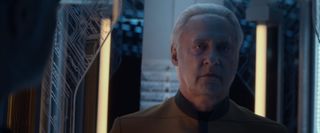
- How Data died in Star Trek: Nemesis
- Data lived on in B-4
- Another Data head?
- Why is Data old now?

What can Data do now?
Warning: Spoilers ahead if you haven't watched "Star Trek: Picard" episode 6, The Bounty .
Even though Spock died saving the Enterprise in "Star Trek II: The Wrath of Khan," Star Trek used the restorative powers of the Genesis planet to bring him back. So when Data made a noble sacrifice of his own in "Star Trek: Nemesis," it wasn't really a surprise when the door was left open – albeit slightly – for the android's future return.
"Star Trek: Picard" season one on Paramount Plus focused heavily on Data's legacy, introducing a family of synthetic offspring and revealing that his consciousness had been preserved in a virtual simulation. Jean-Luc Picard subsequently watched his friend die for a second time, but the show’s third season has just dropped the bombshell that – in true "Jurassic Park" style – something has survived.
In Picard season 3 episode 6 , "The Bounty," Riker, Worf and Raffi Musiker's away mission to the top-secret Daystrom Station reunites them with an old friend, an android with a familiar face who's been given responsibility for the facility's security. But how did Data (still portrayed by actor Brent Spiner) survive certain death in "Star Trek: Nemesis?" Why does he look so much older now? And is he still the same android we knew on the Enterprise-D? These questions and more are answered below. If you're behind, you can catch up on Star Trek: Picard Season 3" with our Star Trek streaming guide .
- Want to watch Star Trek on Paramount Plus? Here's a free trial
- Subscribe to Paramount Plus starting at $4.99/month
Didn't Data die in Star Trek: Nemesis?
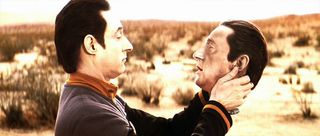
Yes. "Star Trek: Nemesis" is the 10th film in the Star Trek movie franchise and the last to feature the cast of "Star Trek: The Next Generation." It features a clone of Jean-Luc Picard called Shinzon who's out to get Picard (and the Federation), with Data discovering an earlier prototype of himself called B-4 along the way.
In the film's climax, the Picard clone Shinzon had rigged his Romulan/Reman (don't ask) warbird, the Scimitar, to unleash its lethal thalaron radiation weapon on a severely damaged USS Enterprise-E. With Picard on board the enemy vessel, transporters inoperative, and the crew trapped in the quintessential no-win scenario, Data came up with his own solution to the Kobayashi Maru test.
Effectively blowing himself out of an airlock, Data leapt across the void of space to the Scimitar and placed an emergency transport beacon on Picard, who was instantly beamed back to the Enterprise. With the weapon nearly charged, Data fired his phaser at the thalaron generator, destroying himself and the ship in the process. He had sacrificed himself to save his captain and the crew, a fact Picard subsequently struggled to live with. RIP, Data.
Get the Space.com Newsletter
Breaking space news, the latest updates on rocket launches, skywatching events and more!
Data lived on in B-4, or DID he?
Data wasn't the only android built by his creator: genius cyberneticist Dr. Noonian Soong (also portrayed by Brent Spiner).
"Evil twin" Lore (Brent Spiner again) tormented the Enterprise crew on several occasions throughout "The Next Generation," and "Nemesis" introduced the earlier prototype model called B-4 (say the name out loud). Before his death, Data used B-4 as a kind of hard drive to back up his memories and personality, but – aside from sharing Data's ability to recite Irving Berlin standards – B-4's neural pathways lacked the sophistication to replicate his late brother.
But this is where it gets complicated ... The first season of "Picard" revealed that Data's consciousness had survived after all. Along with Soong's human son, Altan (also Brent Spiner), cyberneticist Bruce Maddox – who'd previously tried to prove Data was Starfleet property in classic "TNG" episode "The Measure of a Man" – used a process called "fractal neuronic cloning" to replicate a virtual Data from one of B-4's neurons. This version of the android lived in a "massively complex quantum simulation" until Picard agreed to his old friend's request to help him die for a second time.
There's another Data head in Star Trek: Picard, but whose is it?
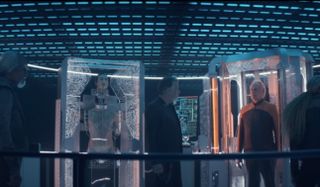
Data, Lore and B-4 were all crafted in Noonian Soong's image, so it's almost impossible to tell them apart. It seems most likely, though, that the disembodied head we see in the top secret Daystrom research facility belongs to B-4.
First, we know from Picard's meetings with Dr. Agnes Jurati in season one that B-4 is in Starfleet’s possession. Second, when Will Riker reminds us that "Data copied everything he was onto B-4," the camera very deliberately cuts to the android head.
There's still a chance, however, that this is a misdirection, and that the head belongs to Lore. We have no idea what happened to Soong's more problematic son after his Borg misadventures in "TNG" two-parter "Descent" – we know he was dismantled but everything beyond that is a mystery. So while it's conceivable Starfleet have brought Lore back somehow, the show would have to fill in some gaps in the canon to explain his presence here.
The head probably isn’t Data's. The explosion at the end of Nemesis was pretty cataclysmic, and besides, if part of Data had survived, surely Maddox, Soong and Starfleet wouldn’t have resorted to using neurons from the inferior B-4 to bring him back.
Why is Data "old" now?

Picard season one used some clever digital tricks to de-age actor Brent Spiner to look like he did in "The Next Generation" era, but the Data we see in "The Bounty" looks much older. His complexion is also much more human.
While the change undoubtedly saved some money on the show’s VFX budget, there's also an in-universe explanation. This is an entirely different type of synthetic body to Data's, much more similar to the "golem" the late Altan Soong gifted to Picard, allowing to survive his incurable irumodic syndrome.
Soong Jr. had originally planned to transfer his own consciousness into the golem before he died, but ended up going down a very different route. He instead decided to combine the consciousnesses of Lore, B-4, Data and Lal (the "daughter" Data built in "TNG" episode "The Offspring") in one body, aka Daystrom Android M-5-10. Soong built this older-looking version "with the wisdom and true human aesthetic of age. With the hope that in totality, something, someone will rise to be the best of us."
That's the million-dollar question, though it's clear there's much more to this new-look Data than simply managing the security systems at Daystrom Station. It’s also clear this isn't quite the Data we knew and loved.
Altan Soong never got the chance to finish the project before he died, leaving the various personalities vying for supremacy within the vessel. Data still recognizes Geordi La Forge, Picard and the rest of the crew, but with Lore also lurking in that shared mind, this resurrected body could be a danger to everyone.
Follow us on Twitter @Spacedotcom on Facebook and Instagram .
Join our Space Forums to keep talking space on the latest missions, night sky and more! And if you have a news tip, correction or comment, let us know at: [email protected].
Richard's love affair with outer space started when he saw the original "Star Wars" on TV aged four, and he spent much of the ’90s watching "Star Trek”, "Babylon 5” and “The X-Files" with his mum. After studying physics at university, he became a journalist, swapped science fact for science fiction, and hit the jackpot when he joined the team at SFX, the UK's biggest sci-fi and fantasy magazine. He liked it so much he stayed there for 12 years, four of them as editor.
He's since gone freelance and passes his time writing about "Star Wars", "Star Trek" and superheroes for the likes of SFX, Total Film, TechRadar and GamesRadar+. He has met five Doctors, two Starfleet captains and one Luke Skywalker, and once sat in the cockpit of "Red Dwarf"'s Starbug.
'The Ark' season 2 is 'love letter' to optimistic classic sci-fi, creators say (exclusive)
Streaming deals on Prime Day's final day: add to Prime Video for 99 cents
Virgin Galactic completes new Delta space plane manufacturing facility in Arizona
Admin said: How is Data in 'Star Trek: Picard' if he died in 'Star Trek: Nemesis?' : Read more
- OneOfTwelve Data already had a built-in aging program according to the TNG episode with his "mother" Juliana. Reply
- Newhouse75 That head is in Mark Twains time. Don't forget. The one in the future was used to restore Data in The future. Reply
- Backcountry164 It's called plot armor. Tripping over yourself making excuses for lazy writers seems pointless... Reply
- View All 4 Comments
Most Popular
- 2 Scientists say they can now forecast El Niño Southern Oscillation years in advance
- 3 New 'Terminator Zero' trailer delivers a heroic dose of Skynet scares (video)
- 4 'There's something in the water!' Shocking final 'Alien: Romulus' trailer goes for the gore (video)
- 5 NASA's Perseverance Mars rover stumbles upon a dusty little snowman (photo)
How Did Data Die On Star Trek & How Did He Return?
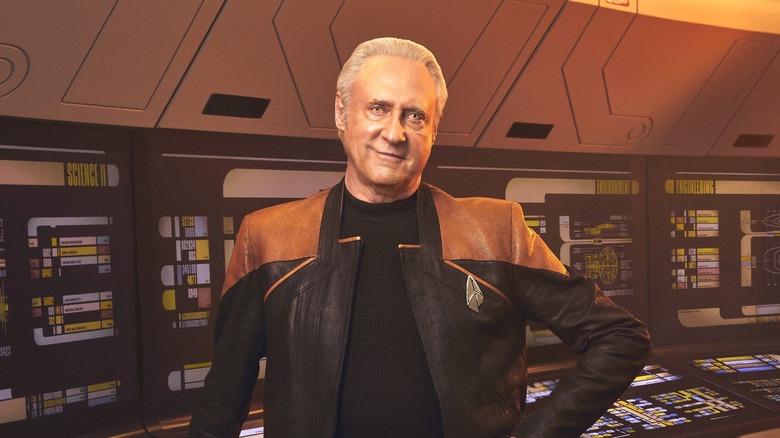
The character of Data, played by Brent Spiner, is one of the most beloved in the "Star Trek" franchise. Fans adored the android and his constant confusion with the behavior of organic lifeforms. His plotlines spanned the gamut from hilarious to deeply philosophical, which is why it was so heartbreaking when he met his end with a heroic sacrifice in "Star Trek: Nemesis." Shockingly, the character appeared to return in "Star Trek: Picard," with Spiner returning for all three seasons. But the truth of Data's return is much more complicated than it seems.
As mentioned, Data's first demise came at the end of 2002's "Star Trek: Nemesis." With a Romulan praetor, Shinzon ( Tom Hardy ) about to unleash a doomsday weapon on the Enterprise, Captain Jean-Luc Picard ( Patrick Stewart ) boarded his ship, the Scimitar, to destroy the generator powering it. Meanwhile, because the transporters were damaged, Data physically leapt from the Enterprise to the Scimitar and made his way to the room where Picard and Shinzon were fighting, arriving just in time to find Shinzon impaled by a spiky beam from the ship's walls. Knowing that the destruction of the generator would blow up the Scimitar, Data pinned an emergency transporter to Picard's lapel and sent him back to the Enterprise, then fired at the generator, sacrificing himself.
For eighteen years, Data remained canonically deceased. Then, in 2020, Brent Spiner returned as the character for "Star Trek: Picard," but it took him all three seasons of the series to finally return to the physical world once more.
Data's Nemesis death was undone with a twisty Picard plot
Brent Spiner returned to "Star Trek" for all three seasons of "Star Trek: Picard," but Data's return was a complicated one. During the events of "Star Trek: Nemesis," the prototype android B-4 was discovered — the third of Noonian Soong's (Brent Spiner) prototypes along with Data's evil brother Lore — and Data copied his consciousness into its positronic net, though the transfer was unsuccessful. Some years after the events of that film, a catastrophic attack by unknown synthetic lifeforms caused the Federation to issue a total ban on synthetic life, as we learn in the pilot episode of "Picard." Unknown to anyone, Data's consciousness lived on in B-4, which was stored at the Daystrom Institute.
Picard died in the two-part finale of "Picard" Season 1, and his own consciousness was transferred to a synthetic body. In the process of being uploaded, Picard encountered Data's consciousness, which still survived inside the remains of B-4. Data asked his old friend to terminate the program and kill him for good, which Picard did. However, Noonian Soong's son, Altan (Brent Spiner) soon began work on a new android that would combine the traits of Data and Lore. The nefarious Section 31 confiscated the prototype and stored it at Daystrom Station. When Picard and his friends boarded the station in "Picard" Season 3, they found the prototype and discovered the Data and Lore sides of it were in conflict. Data ultimately defeated Lore, warring inside the positronic net, and was himself once more, but this time with the emotions he'd always wanted. He returned to the Enterprise to serve again.
Spiner may not return to the "Star Trek" universe again, but he and fans can both rest assured that Data lives on.

- July 18, 2024 | Recap/Review: ‘Star Trek: Prodigy’ Learns An Adorable Lesson In “A Tribble Called Quest” [Episode 213]
- July 18, 2024 | 2 More Cadets Cast For ‘Star Trek: Starfleet Academy’ – Prep Work Already Started In Toronto
- July 17, 2024 | “Star Trek Origin” Movie Tidbit: Reportedly Set Mostly On Earth
- July 17, 2024 | Recap/Review: ‘Star Trek: Prodigy’ Navigates The Storm In “The Last Flight Of The Protostar, Part I & II” [Ep. 211/212]
- July 17, 2024 | ‘Star Trek: Strange New Worlds’ And ‘Lower Decks’ Nominated For Emmy Awards
Interview: Brent Spiner On How Data’s Evolution In ‘Star Trek: Picard’ Fits Gene Roddenberry’s Original Plan
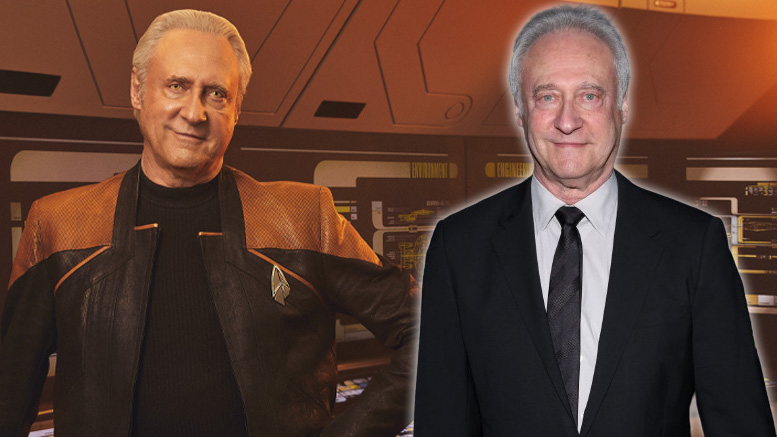
| February 20, 2024 | By: Anthony Pascale 23 comments so far
This year at the Saturn Awards , the cast of Star Trek: The Next Generation was honored with a lifetime achievement award. Brent Spiner attended the event with his other co-stars, also celebrating their Saturn-winning return in Star Trek: Picard . TrekMovie had a quick moment to speak with the actor about Data’s return in Picard and if he’s interested in playing the character again. There’s also an update on Spiner reviving another character from his past.
Gene Roddenberry was also honored with this same Saturn lifetime achievement award. You knew Gene, and he created the character of Data. What do you think he would think of how Data evolved through TNG, into the movies, and now in Picard ?
I think he would think it all went according to plan. Because one thing he said to me from the very beginning when I first met him, he said, “What I want is for Data is for him to get more and more and more and more human as time goes on, and by the end be almost human, but still not.” And that’s kind of where we are, I think.
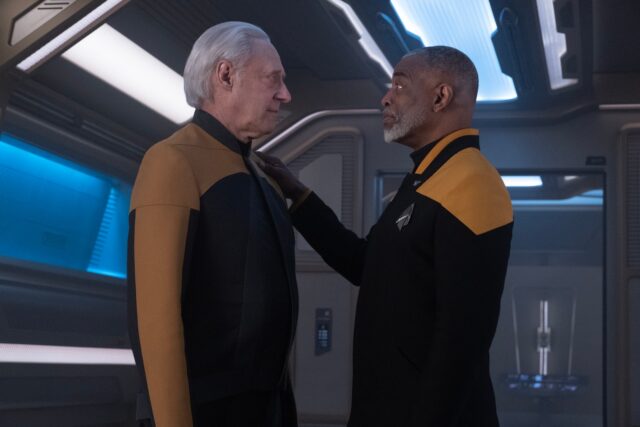
Brent Spiner as Data and LeVar Burton as Geordi La Forge in “Surrender” (Paramount+)
So for the Data from the end of Picard , you don’t see him as a new different character but as an evolution of Data?
He really is an evolution. I think what’s interesting about it is that for years and years and years, I was trying to become Data. And now in the latest iteration, Data has sort of become more like me.
What of Lore did you try to keep in your performance in those last episodes as Data? What of your bad side did you try to hold on to?
Actually of the two characters—Data and Lore—I’m much more like Lore. I mean, Lore was easy to play because I am evil. So they said, “Yeah, just let yourself go, be yourself.” So, okay!
If there was a chance to do more with the character… everyone else seems to be on board, are you also on board if Legacy ever happens?
I really don’t even want to weigh in on it. It’s hypothetical at the moment. I’d be happy to another ER if they want to do it [laughs]. I just like to work. Certainly, if they came to me and I wasn’t doing something else, I’d love to do it.
Spiner returning to Night Court
While Brent Spiner’s return to Star Trek is still up in the air, he will be reprising another character from his past. TV Line has reported that Spiner will appear in the newly revived NBC sitcom Night Court . Before his time on Star Trek: The Next Generation , Spiner had a recurring role in the original Night Court , appearing in six episodes as the hard luck case Bob Wheeler , who often found himself in front of Judge Stone. According to TV Line, Spiner will be reunited with Annie O’Donnell, who played Bob’s wife, June Wheeler. The episode will feature the Wheelers’ daughter, played by Kate Micucci.
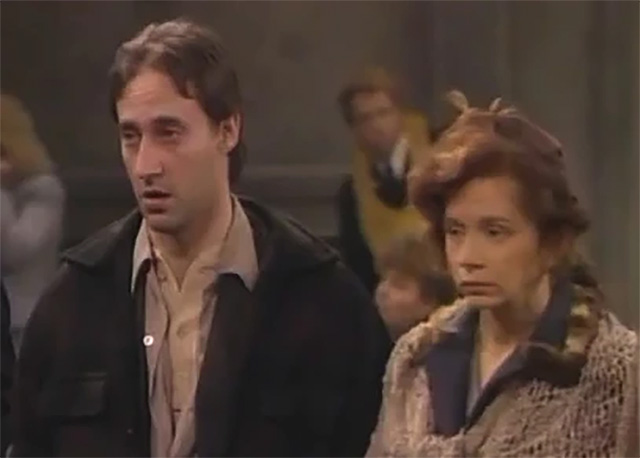
Brent Spiner and Annie O’Donnell in the original Night Court (NBC)
More red carpet interviews from the Saturn Awards
TrekMovie spoke to more Star Trek presenters, nominees, and winners at the Saturn Awards, so come back for more interviews and updates.
Check out our earlier Saturn Awards interviews:
- Doug Jones on Discovery
- Tawny Newsome on Lower Decks and Starfleet Academy
- Terry Matalas on Picard season 3 and hopes for Legacy
- Jeri Ryan on Seven’s arc from Voyager to Legacy
- Michelle Hurd and Todd Stashwick on Picard memes and Legacy dreams
- Paul Wesley on Strange New Worlds season 3 and beyond
- Wil Wheaton on playing Wesley in Lower Decks , and Ready Room update
- Nicolas Cage’s desire to be in Star Trek
- Danai Gurira’s almost casting for Star Trek 4
- Zach Galligan on appearing in Voyager and auditioning for Trip in Enterprise
You can hear audio from these interviews and more in the latest All Access Star Trek podcast .
Keep up with news about the Star Trek Universe at TrekMovie.com .
Related Articles

Interview , Star Trek: Prodigy
Interview: ‘Prodigy’ Showrunners On Giving Wesley Crusher Closure And Sitting At Star Trek’s “Adult Table”

Games , TNG
World Of Warships Launches ‘Star Trek: The Next Generation’ Collaboration – Watch Launch Video
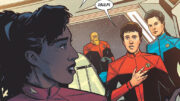
Comics , DS9 , Lower Decks , TNG
See Alt Universe Mariner Face Off With Q Jr. In Preview Of ‘Sons Of Star Trek’ #4

Interview: Dan And Kevin Hageman On How ‘Star Trek: Prodigy’ Season 2 Is Different, And What May Come Next
I was happy with the direction of the character over all. It was great to see Brent back in the make up.
Fun fact: Annie O’Donnell also did Star Trek. She was a mute Bajorin in “Progress”
coming to say the same thing!
She was also the bed and breakfast keeper w/ all the cats in Parks and Recreation
Absolutely adore and love both Spiner and Data, easily one of my favorite characters. A big reason I didn’t like Nemesis much was because they killed off his character.
I was very grateful to see him return in Picard and loved him in both seasons. If they make Legacy I would love for him to return in that as well. If not they ended his character beautifully in Picard.
Yes! Bob Wheeler returns! I’ve been waiting.
I just spent the last weekend in LA where I got to hang out with Brent at an auction, called Studio Auctions, where they sold a phaser from 2009 and a Horta egg from Greg Jein’s collection. I am now the proud (if somewhat broke) owner of the egg. Brent was so funny as always, and told me he was looking forward to the upcoming Trek cruise. I also got to hang with Lee Majors, the Six Million Dollar Man. Altogether it was a really interesting experience seeing the behind the scenes production of a major auction. They sold the hoverboard from Back to the Future II for $150k, and an R2D2 from Obi Wan for half a million. I’d say they had a good day, and so did I – I got to hang out with one of my favorite actors!
Yea, Lee Majors is the man.
That sounds like a pretty fantastic weekend – cheers!
We’ve had a Data overload. He needs unplugging for good.
After John Laroquette dressing up as Maltz, this just ones up it. The New Night Court is shaping up to be the same Trek loving show Big Bang was!
my hot take is that Big Bang Theory sucks. It’s not a love letter to nerds, it was created by jocks to make fun of nerds. And that nerds don’t see that it’s actually condescending and patronizing is it’s best joke. It’s a collection of nerd memes “hey bro, google stuff nerds like: Star Trek, Stephen Hawking”.
The one funny joke I ever heard in it was the incorrect math calculation that was published. That was a good bit.
“ my hot take is that Big Bang Theory sucks.”
Is…this hot?
I’ve heard the argument that its the show for nerds that pretends to be your friend.
It can also be argued that it takes shots at antisocial pockets of fandom rather than fandom itself, which it allows its characters to grow out of as the series progresses.
I don’t have a strong opinion either way. I’m not really a sitcom guy.
I get that OP and I see why you would think that. But counterpoint, Leonard, the “geek” got the “cheerleader” so to speak. So did Howard.
Once more female characters appeared as regulars in TBBT then it stopped seeming to be at the expense of ‘nerds’
The Hoops and Sharks they had to jump through to get that old man to play Data again. It would have been much more realistic to get a new actor to play Data, but that’s what happens when hacks use nostalgia as a shortcut and a crutch.
In that case, realism doesn’t sound very satisfying.
Reality never does.
Can’t argue with that.
I liked the way he was written in for season 3, it seems plausible, imo (taking into consideration the franchise we’re in), and I think Spiner did a great job with the material. As to a Legacy show, if we ever do see one, if he came back in the same incarnation I would have no issue with it. That said, if this is the last time we see Data, I think the character has come full-circle. It was a fine send-off. Honestly, what I’d really like to see more of is Dorn’s zen-Worf – loved how he played that.
The handling of the Data character was my favorite of the series. Matalas took Roddenberry’s direction and really brought Data as close he can possibly be to humanity without being fully human. I love the combining of Lore and Data in their minds. It reminds me of TOS episode The Enemy Within when there was a good side / bad side to Kirk, he then had to combine both to be fully human. The little touches to Data’s growth was neat, like when he put his hand on a grieving Picard’s shoulder to show empathy and support. I really liked the therapy session with Troi at the end, Data is not only almost fully human, but a neurotic one at that! Great way to end the character’s story.
But, like others had said, I think this should be the end of the TNG characters. This is the end of Data’s journey, so it seems right to just stop.
First Splinter did it better.
I hope we will see the upgraded Data again!!!!
Star Trek: Picard: how Data died, and his appearance in Picard explained
The death of Data explained, and what his appearances in Picard mean

If you've been watching Star Trek : Picard, you may have a few questions about Data, the android who appears in Picard's dreams – and who may very well be the 'father' of new characters Dahj and Soji. Data was an important character in The Next Generation, which this new series is a direct continuation of, and he led an interesting life. So here's everything you need to know about Lieutenant Commander Data, including how he ultimately died in the movie Star Trek: Nemesis.
- How to watch Star Trek: Picard
- When is Star Trek: Picard episode 2 released?
- Our Star Trek: Picard episode 1 recap
Who is Data?
Data was an android designed by Dr. Noonian Soong, a brilliant cyberneticist. Other androids exist in the greater Star Trek universe, but Data's positronic brain gave him a greater depth and nuance of personality – to the point where the Federation considered him sentient, with the same rights as any biological being.
Data was unable to feel emotion, however, and struggled to understand the many idiosyncrasies of the human race. But he was still capable of loyalty, wisdom, friendship and sensitivity, which earned him many friends when he served aboard the Federation starship Enterprise.
How did Data join Starfleet?
A mysterious alien life-form known as the Crystalline Entity destroyed a colony on the planet Omicron Theta, and Data's deactivated body was discovered among the debris by the USS Tripoli. He was revived by the Federation, and was accepted into Starfleet Academy when it became apparent that he had achieved a level of sentience never before seen in a synthetic being.
Data graduated, despite the social challenges of being the only android in the academy, and served as an ensign aboard the USS Trieste, before being assigned to the Enterprise-D in 2364 – which is where we meet him in The Next Generation.
How did Data die in Star Trek: Nemesis?
Nemesis was the last of the Next Generation movies. Released in 2002, it starred Tom Hardy as Shinzon, a clone of Picard who stages a violent coup and becomes leader of the Romulan Empire. At the end of the movie, Data sacrifices his own life to save Picard's, destroying Shinzon's ship in the process. Before he died, Data downloaded his memories into a prototype Soong-type android, B-4. But this model's positronic brain was not as advanced as Data's, meaning he had none of his brother's individuality or personality: just raw memories.
How can Data be in Star Trek: Picard?
Brent Spiner reprises his role as Data in Star Trek: Picard, only in dreams so far. Picard is still haunted by the loss of his friend, and the heroic sacrifice he made to save his life. So whenever you see Data in the new series, it's Picard experiencing a vision; an echo of the past. But who knows what the rest of the series has in store? Perhaps we'll see a return of the old Data at some point in this story – although that might cheapen his sacrifice in Star Trek: Nemesis somewhat.
Get daily insight, inspiration and deals in your inbox
Sign up for breaking news, reviews, opinion, top tech deals, and more.
Is Data still alive in Star Trek: Picard?
Alas, the Data we knew from The Next Generation is gone forever. But a major plot point in season one of Picard is his memories – the ones he downloaded to B-4 – being used to create two 'daughters', Dahj and Soji. These android twins were designed by Dr. Bruce Maddox, a cyberneticist, using a process called fractal neuronic cloning. So while Lieutenant Commander Data of the USS Enterprise, lover of cats and Sherlock Holmes, is no more, his spirit lives on in them.
Star Trek: Picard is released every Thursday on CBS All Access in the US, and every Friday on Amazon Prime internationally.
- More of a Star Wars fan? Here's what we know about The Mandalorian season 2
- Everything we know about Star Trek: Strange New Worlds
How to watch U19 Euro Championship 2024 live streams from anywhere
How to watch Alcaraz vs Djokovic live stream: Wimbledon 2024 for free, Alcaraz one set away from victory
I review tablets for a living and the iPad mini for $379.99 is a must-buy for Prime Day
Most Popular
- 2 I tried the first smartphone-based telescope and got next-level photos of the moon – next up, galaxies and nebulae
- 3 Quordle today – hints and answers for Saturday, June 29 (game #887)
- 4 Everything new on Prime Video in July 2024
- 5 Is Proton VPN legit? An honest analysis of the service and its parent company
- 2 Ryse SmartShades are a pricey but intuitive way to bring old-school-shades into the world of the smart home
- 3 Even Apple Intelligence can’t save the smart home if Apple won’t fix its infuriating Home app
- 4 Microsoft has gone too far: including a Game Pass ad in the Settings app ushers in a whole new age of ridiculous over-advertising
- 5 Microsoft's Copilot+ AI PCs aren't all that special right now, but there's one major reason why that's about to change
Den of Geek
Specifications
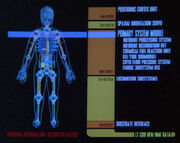
A diagram of Data's systems
Data's appearence resembles that of young dr. Noonien Soong ( TNG : "Birthright, Part I" ). He was composed of 24.6 kilograms of tripolymer composites, 11.8 kilograms of molybdenum - cobalt alloys and 1.3 kilograms of bioplast sheeting. ( TNG : " The Most Toys ") All told, his mass was approximately one hundred kilograms. ( TNG : " Inheritance ") Data's upper spinal support was a polyalloy designed to withstand extreme stress. For instance, Data once leaped into a deep underground cave and was able to safely fall down 11.75 meters to the bottom without damaging himself. ( TNG : " The Arsenal of Freedom ") His skull was composed of cortenide and duranium . ( TNG : " The Chase ") His legs were exactly 87.2 centimeters in length. ( Star Trek: Insurrection ) Data was built with an ultimate storage capacity of eight hundred quadrillion bits ( 100 petabytes ) and a total linear computational speed rated at sixty trillion operations per second . ( TNG : " The Measure Of A Man ") However, he later augmented his computational speed by converting his interlink sequencer to an asynchronous mode of operation, removing the performance constraint created by virtue of having space between his positronic links. His computational speed became virtually instantaneous after this modification. ( TNG : " The Quality of Life ") Data's construction also included teeth , an artificial tongue and tear ducts . ( TNG : " Code of Honor ", " The Bonding ", " Brothers ", " Phantasms ", " Thine Own Self "; Star Trek Generations )
His physical and mental capabilities were far superior to that of virtually any organic or cybernetic humanoid, including Klingons, Humans, and even Borg drones . His strength was such that he was capable of casually holding a 1950's automobile at bay against the full force of its engine with a single hand. ( TNG : " The Neutral Zone ", " The Ensigns of Command ", " The Chase ", " The Best of Both Worlds, Part II ", " Emergence "; Star Trek: First Contact ) These superhuman capabilities made him an important asset to the Enterprise -D, and the fact that he was either unaffected by or highly resistant to conditions such as disease , radiation , oxygen deprivation, mind control, and chemical imbalance was crucial to the survival of the ship on numerous occasions. ( TNG : " Unnatural Selection ", " The Vengeance Factor ", " Hero Worship ", " Clues ", " Disaster ", " The Game "; Star Trek: First Contact ) However, he was apparently more vulnerable than either Humans or Klingons to atmospheric conditions that involved the presence of high concentrations of ions. For instance, during the Enterprise 's mission to Galorndon Core in 2366, Commander Riker noted that had Data been with the away team, the crew would have been "unscrambling his circuits for a week". ( TNG : " The Enemy ")
As a Soong-type android, Data was incapable of alcohol intoxication , yet components in his processing systems were susceptible to disruption by polywater intoxication . ( TNG : " The Outrageous Okona ", " The Naked Now ") He did not require sustenance , but occasionally ingested semi-organic nutrient suspension in a silicon -based liquid medium to lubricate his biofunctions. ( TNG : " Deja Q ") Though capable of consuming more traditional food and drink, Data had no sense of taste and therefore tended not to bother eating. ( TNG : " Hero Worship ") Data also did not sleep, nor apparently did he require rest of any kind. Though he had attempted sleep from time to time, presumably simply to emulate Humans more thoroughly, he appeared to have remained almost constantly active before 2369 . After this date, Data suffered an accident which activated a series of circuits in his positronic net that allowed him to experience dreams. After this, he began to sleep regularly in order to experience these dreams. ( TNG : " Birthright, Part I ") Data also demonstrated immunity to telepathy and other psionic abilities. Deanna Troi could not sense him empathically ; nor was he affected by the telepathic broadcasts of the Bendii Syndrome -afflicted Sarek . ( TNG : " Night Terrors ", " The Game ", " Violations ", " Phantasms ", " Sarek ") This was known to trouble him to a certain degree, as he believed that it was possible that there was simply nothing "real" in his mind for these individuals to read; that his consciousness was comprised only of "algorithms and programmed responses". However, the psionically-gifted Betazoid Tam Elbrun vehemently disagreed with this possibility, thinking Data was simply "different". In fact, Tam greatly appreciated this quality in Data, as it meant that he had to talk with Data to understand his personality rather than involuntarily receiving that information telepathically, as tended to be the case when he interacted with other humanoids. ( TNG : " Tin Man ")
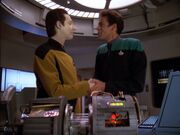
Data and Dr. Bashir
Data had an aging program designed to simulate the external effects of aging in his physical appearance. The blinking of his eyes was governed by a Fourier series , to simulate randomness. ( TNG : " Inheritance ") In 2369 , Dr. Julian Bashir further expressed his fascination for all the trouble Dr. Soong took to make Data seem "Human." He was especially surprised with regard to how "personable" Data was. He also questioned Data about whether his hair grew, and observed that Data was "breathing" and had a "pulse." However, these seemingly aesthetic elements of his person did in fact serve a functional purpose, as his circulatory system was designed to produce biochemical lubricants and regulate micro-hydraulic power, and his respiratory system helped to maintain thermal control of his internal systems. Neither system was entirely necessary however, as Data was known to be capable of functioning for extended periods in a vacuum and was able to withstand exposure to space without suffering any problems. ( TNG : " Birthright, Part I ", " We'll Always Have Paris "; Star Trek Nemesis )
Data seemed to favor his left hand for tasks such as painting, ( TNG : " 11001001 ") using a pen, ( TNG : " Time's Arrow ") gun tricks, ( TNG : " A Fistful of Datas ") and more. However, he was completely ambidextrous and was even capable of performing such tasks as painting two pieces at once. ( TNG : " Birthright, Part I ")
Brent Spiner is left handed.

Data demonstrates his flotation capabilities
Before 2370 , Data was apparently incapable of swimming as his body structure was too dense for him to float in water. He apparently learned this through trial and error, as at one point prior to the date in question, he decided to go swimming in Devala Lake while sailing with Geordi La Forge . He immediately sank straight to the bottom, and he ended up having to walk 1.046 kilometers across the lake bed to the shore, as he did not possess enough buoyancy to get back to the surface. It took nearly two weeks to get the water out of Data's servos . ( TNG : " Descent, Part II ") Data had rectified this problem as of 2375 , and installed some sort of flotation device within his body which was buoyant enough to support not only his own weight but that of others. ( Star Trek: Insurrection )
It could be presumed that Data also rectified the problem of water invading his servos, if it was not the prolonged submerging underwater itself that caused it.
Human development
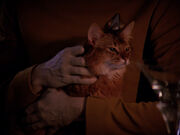
Spot in 2367
Data asserted that he did not only perceive data and facts, but also the "substance" and "flavor" and other ineffable qualities of the experience, which would be lost when downloaded to a conventional computer. ( TNG : " The Measure Of A Man ")
Data always sought to become more Human in his behavior, sometimes with unfortunate results. His attempts at humor were not successful, nor were his attempts at romance and love. He maintained a relationship with Jenna D'Sora , but it did not last long. ( TNG : " In Theory ")
Data's comment to the Borg Queen in Star Trek: First Contact regarding how long it had been since he last had sex with a woman would seem to indicate he was referring to Tasha Yar . This suggests that Jenna and Data never had sex during the course of their relationship.
Besides humor and romance, Data also tended to avoid using contractions in regular speech as he had difficulty defining the nuanced occasions on which they were used, although this was part of his programming by Dr. Soong. ( TNG : " Conspiracy ", " Datalore ")
In an alternate timeline, Data appeared to have mastered contractions by the 2390s. ( TNG : " All Good Things... ")
However, in some episodes such as " Encounter at Farpoint ", " The Naked Now ", and " Justice " Data uses some contractions.
During his stay aboard the Enterprise -D, Data kept a cat as his pet , whom he named Spot . Spot was quite fussy in her relationships. Besides Data, she only enjoyed the company of Reginald Barclay . She also had kittens in 2370 . In 2371 , Spot survived the destruction of the Enterprise . Data, newly imbued with emotions as a result of his emotion chip , cried tears of joy over Spot's survival. ( TNG : " In Theory ", " A Fistful of Datas ", " Force of Nature ", " Genesis "; Star Trek Generations )
Emotion chip
Data began using the emotion chip in 2371 , about a year after he acquired it from his brother Lore . ( TNG : " Brothers ", " Descent, Part II "; Star Trek Generations ) At first, he had some difficulties adjusting to the onslaught of emotions, as simple things such as scanning for lifeforms on a planet caused him great pleasure – whereas by contrast, Data was temporarily immobilized with terror when put in a situation where he would experience fear for the first time. He eventually learned to control the feelings. After the initial adjustment period, he was able to activate and deactivate the chip's functioning within his positronic net, and later even to remove it completely in situations where emotions would be a hindrance. ( Star Trek Generations ; Star Trek: First Contact ; Star Trek: Insurrection )
Service record
Creation and early life.
Data was constructed on the planet Omicron Theta around 2336 . He was the fifth of six known androids designed by Dr. Noonien Soong . The previous, Lore, had been deactivated over the protests of Soong's wife, Juliana . ( TNG : " Datalore ", " Inheritance ") Soong claimed he built Data to perfect his design of his androids, and when Data was perfected, apply his improvements to Lore. ( TNG : " Brothers ") Juliana had come to view Data as her beloved son, but always feared that he would fail, as his previous "brothers" had, or become dangerous, like Lore, and would have to be dismantled. ( TNG : " Inheritance ")
In his earliest existence, Data was much like a baby, struggling with motor control and sensory input. ( TNG : " Inheritance ") Over time, Data had learned about himself and his world, and his programming was refined by Dr. Soong, who attempted to eliminate certain undesirable behaviors. Problems included a disregard for social niceties, courtesies like "please" and "thank you", and a lack of appreciation for clothing, Data did not see any necessity since he "didn't suffer from the elements". In regards to the latter issue, the Soongs had to write a "modesty subroutine ", because the colonists objected to an anatomically-accurate android being unclothed. ( TNG : " Inheritance ")
Eventually Soong decided to feed Data with the logs and journals of the colonists, while simultaneously wiping his memory of his early existence. Unfortunately, while Data was still deactivated, a mysterious Crystalline Entity attacked the colony. ( TNG : " Datalore ") Juliana's fears that Data would be another failure motivated her to lie to her husband when they fled, forcing him to leave Data behind, inactive. ( TNG : " Inheritance ")
Data remained alone on the planet, inactive and abandoned by the colonists until he was discovered by a landing party from the USS Tripoli on Omicron Theta.
Discovery and early career
Data was found and reactivated on the planet Omicron Theta by the USS Tripoli on February 2 , 2338 , after the Crystalline Entity destroyed the entire colony on the planet. ( TNG : " Datalore ", " Conundrum ")
In the first few weeks after Data was reactivated, and without the early presence of Noonien and Juliana Soong, Data claimed he had no one to guide him as his neural net was developing and achieving sentience . ( TNG : " The Offspring ") In that process, more complex pathways replaced simpler ones. As the integration of these pathways became increasingly difficult, the probability of cascade failure increased. As a consequence, Data considered shutting himself down and beginning all over again. He eventually considered the situation a challenge and continued on. He later expressed to La Forge that, in essence, he considered suicide at a difficult point in his early life. ( TNG : " Eye of the Beholder ")
His connection with Starfleet resulted in his choice to enter Starfleet Academy . ( TNG : " Brothers ") Upon applying for admittance to the Academy, Data met with some resistance from Bruce Maddox – who, desiring the opportunity to avail his cybernetic research interests, became, as Data put it, " the only member of the evaluation committee to oppose [Data's] entrance on the grounds that [he] was not a sentient being. " Eventually, Data was admitted to the Academy in 2341 , and spent four years there. ( TNG : " Encounter at Farpoint ", " The Measure Of A Man ") While at the Academy, Data undertook advanced training in the operation of auxiliary space vessels where he received a high grade . ( TNG : " Unnatural Selection ")
Prior to 2364 , Data had been cited in several bio-mechanical texts. ( TNG : " The Naked Now ")
During his time at Starfleet Academy, Data did extremely well scholastically, but his lack of understanding often created social obstacles for him. He fell victim to several practical jokes and had difficulty with social gatherings. ( TNG : " The Game ") Nonetheless, in 2345 , Data graduated, with honors in exobiology and probability mechanics . ( TNG : " Encounter at Farpoint ", " The Measure Of A Man ", " Tin Man ")
One of Data's first assignments after he graduated Starfleet Academy was aboard the USS Trieste . ( TNG : " Clues ") He spent three years as an ensign and twelve as a lieutenant before being promoted to lieutenant commander in 2360 . ( TNG : " Datalore ") In 2364 , he was assigned to the USS Enterprise -D as its second officer .
By 2365 , he had earned the Starfleet Command Decoration for Gallantry , Medal of Honor with clusters, Legion of Honor , and the Star Cross . These were considered by Wesley Crusher to be "Some of the highest awards in Starfleet." ( TNG : " The Measure Of A Man ", " The Most Toys ") By early 2368 , Data had encountered 1,754 non-Human races during his tenure with Starfleet. ( TNG : " Darmok ")
Aboard the Enterprise
Data served as operations officer and second officer on board the USS Enterprise -D from 2364 until the vessel's destruction in 2371 . ( TNG : " Encounter at Farpoint ", " All Good Things... "; Star Trek Generations ) Since he did not require sleep, he routinely stood night watch on the bridge. ( TNG : " Data's Day ") His quarters were located on deck 2, room 3653. ( TNG : " A Matter Of Time ") He frequently participated in away missions undertaken by the crew, as was indicated by standard procedure for the second officer of a Federation starship.
Shortly after the Farpoint mission, the Enterprise crew was infected with a polywater intoxication which caused the crew members and even Data to act irrationally, as if mentally unstable. Fortunately, Dr. Crusher found an antidote, and with Data's help the recovered crew was able to retain control of the ship. ( TNG : " The Naked Now ")
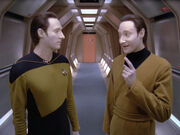
Data gives Lore a tour of the ship
During the Enterprise 's first year of active service, it visited the former colony of Omicron Theta, stopping there to investigate the site of Data's discovery. The crew of the Enterprise encountered another Soong-type android in an underground facility, named Lore. Lore was subsequently reassembled and activated aboard the Enterprise . Masquerading as Data, Lore attempted to take control of the ship, but was prevented from doing so by Data. Lore was transported, by Wesley Crusher off the ship, into space (Lore drifted in the interstellar void for two years before being rescued by a passing Pakled trade ship ). ( TNG : " Datalore ", " Brothers ")
Later that year, Data took overall command of the Enterprise when the Quazulu VII virus incapacitated the entire crew while in orbit around Angel I . Although the ship had been ordered to the Romulan Neutral Zone , Data's precise and reasoned interpretation of the orders allowed the Enterprise to remain in orbit long enough to rescue the away team members stranded on the planet. ( TNG : " Angel One ")
Data had been regarded as property by the Ferengi , who wanted to purchase him. He was also referred to as "just a device" by Armus . ( TNG : " The Battle ", " Skin Of Evil ") He continued to be regarded as such in 2365 and was even questioned legally as to whether or not he was property of Starfleet.
Android rights and freedoms
Data was a major influence in the process to legally and socially recognize the sentience of Soong-type androids. In 2365 , Jean-Luc Picard was asked by Admiral Nakamura on behalf of Commander Bruce Maddox to submit Data to an untested procedure that Maddox believed and had advocated would grant Federation cybernetic science a greater understanding of the technology of Data's positronic brain . Data studied Maddox' proposal and found it to be flawed; persuading William T. Riker and Picard of the legitimacy of Data's position as to the scientific merit of Maddox' project; prompting Maddox to present Nakamura's duly-logged orders requiring Data to submit.
Data refused, and resigned from Starfleet. Maddox challenged Data's right to do so, implying that Data should not be considered a sentient being with rights to self-determination (Louvois reminds Maddox " …we have Rule of Law in this Federation. You cannot simply seize people and experiment on them to satisfy your pet theories! "). Maddox's petition prompted Louvois' supposition of a legal issue as to whether or not Data was property and not to be accorded rights to self-determination (" Would you permit the Enterprise computer to refuse a refit? " Maddox asked Louvois). This position was supported in a preliminary ruling, by Captain Phillipa Louvois of the Judge Advocate General 's office, 23rd Sector, based on the 21st-century Acts of Cumberland . (" Data is a toaster. Have him report to Commander Maddox immediately for experimental refit. ")
Captain Jean-Luc Picard adversarially challenged this ruling, and sought due process of law in Data's regard. Picard asserted a position in favor of Data's sentience as a matter of law, in a legal hearing wherein Picard advocated on Data's behalf while Riker advocated a position benefiting Maddox (Riker was forced to argue against Data's sentience or Louvois would summarily rule in favor of Maddox without a counter-argument). After a conversation with Guinan , Picard became inspired to assert that Data represented an entire race, and that duplicating Data for the purposes of enforced and potentially-dangerous labor, without legal recognition of rights to self-determination, essentially would result in the institution of slavery. Ultimately, Louvois ruled that Data was not the property of Starfleet, and had the legal right to choose whether to acquiesce to Maddox' requests. ( TNG : " The Measure Of A Man ") Data refused Maddox' procedure, but did instead offer to openly communicate with him in assisting him in his work, which the cyberneticist accepted. ( TNG : " Data's Day ")
The ruling from Louvois and the Starfleet Judge Advocate General was relatively ambiguous. The ruling was only that Data was not the property of Starfleet and accorded him "the right to choose" at least under Starfleet rules and regulations, if not also under wider Federation law. Though those two holdings together could be interpreted as tantamount to a favorable ruling as to Data's sentience under Federation law. Louvois did declare at the outset of the hearing depicted in TNG : " The Measure Of A Man " that the purpose of the hearing was to determine Data's "legal status"; and Picard and Louvois noted the significance of the enduring legal consequence and implication of a lawful determination as to Data's sentience.
The legal question thus remained open whether Data was a "sentient being" under Federation law. Starfleet regulations, including the Federation Uniform Code of Justice , are a subset of Federation law, and only apply to members of Starfleet; whereas Federation law applies to anyone within the jurisdiction of the Federation, including members of Starfleet. Data's legal status subsequent to the events in TNG : " The Measure Of A Man " may be inferred from Picard's comments to Data in TNG : " Clues ". There, Picard stated that Data's fate subsequent to a contemplated court-martial could involve him " being stripped down to [his] wires to find out what has gone wrong " – a punishment disparate with what an organic Starfleet officer might suffer in consequence of a court-martial.
No further information regarding Data's legal status as a sentient being is presented in the episodes or movies. However, in many ways, the intrigue of this plot element was carried over with The Doctor 's fight for equality.
Data also later asserted specific reproductive rights. In 2366, Data perfected submicron matrix transfer technology, necessary to reproduce a positronic brain . Data designed and built his " daughter ", whom Data named Lal ; Data says "Lal" means "beloved" in Earth's Hindi language; using his own positronic brain as a design template. Thus, Data briefly succeeded at Maddox' aspiration. As Starfleet Vice Admiral Haftel , himself a cybernetics specialist, wanted to move Lal off the Enterprise -D to a Starfleet cybernetics research facility for study in order to add to Federation cybernetics expertise, against Data's wishes, Picard again came into conflict with the Starfleet Admiralty as to Data's civil rights. The issue was rendered moot when Lal ceased functioning due to positronic neural-pathway cascade failure arising from the positronic development within Lal of the simulation of Human psychological emotional response. This, despite the best efforts of Data and Haftel to prevent Lal's positronic matrix from ceasing to function as a result. ( TNG : " The Offspring ")
Many agreed with Data that Soong-type androids were sufficiently advanced to be considered indeed sentient, so much so that, as of 2372 , Data was considered the only sentient artificial lifeform in Federation society. ( VOY : " Prototype ")
Further service
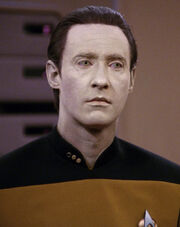
Lieutenant Commander Data in 2366
In 2366, the Enterprise -D was contacted by Sheliak Corporate for the first time in 111 years. In a recorded message, set on repeat broadcast from the Shelia system, they demand that on Tau Cygna V , a planet that was ceded to the Sheliak from the Federation in the Treaty of Armens has been discovered to contain a Human colony. The Sheliak insist they be removed before they arrive at the planet, or the Humans will all be killed. Data – immune to the deadly hyperonic radiation that exists on the planet – was ordered to take a shuttle craft and land at the planet and prepare the colonists for evacuation. Unfortunately, the colony's leader Gosheven was both far too stubborn and nostalgic for all his ancestors' accomplishments on the planet to agree to leave even after several attempts to persuade him or other colonists, even with the help of Ard'rian McKenzie , one of the few reasonable colonists. Eventually, through a demonstration of the firepower of a Type 2 phaser , Data was able to finally convince the colonists to leave, thereby saving over 15,000 Humans from certain death. ( TNG : " The Ensigns of Command ")
In late 2366, Data was apparently killed when the shuttlecraft he was using to ferry hytritium , desperately needed to neutralize contamination of the water on Beta Agni II , exploded en route from the freighter Jovis to the Enterprise -D. In fact, Data had been abducted by the owner of the Jovis Kivas Fajo , who had added Data to his collection of "rare and valuable" items – which, now besides Data, included a Lapling , a Roger Maris Baseball card , and a Varon-T disruptor . Fortunately, Data, with the assistance of Fajo's partner Varria , as well as the arrival of the Enterprise , was able to escape the Jovis ; the unanticipated ease with which the hytritium purified Beta Agni II's water suggested that the contamination had been man-made, leaving the crew suspicious of Fajo – and, after hearing the computer's description of only a part of Fajo's collection, they had concluded that Data could be considered a "rare and valuable object", leading them to the possibility that Data had not been on board the shuttle when it exploded. Upon Data's return to the Enterprise -D, Fajo was arrested. Data had previously mentioned to Fajo his ability to use deadly force and had it not been for the functioning of the Enterprise transporter retrieving Data from the Jovis , Data would have successfully shot and killed Fajo with the Varon-T disruptor, in retribution for Fajo previously having killed Varria with it and through a cold, logical decision that all nonlethal options had been exhausted. ( TNG : " The Most Toys ")
When later that year, Captain Picard was captured and assimilated as Locutus by the Borg , Data was instrumental in not only rescuing Picard from the Borg, but also in finding a way to destroy the Borg cube approaching Earth by "put[ting] them all to sleep," accessing the command codes that controlled regeneration and convincing the Borg that they all needed to regenerate, thus shutting the ship down and triggering a feedback loop that caused the cube to self-destruct. ( TNG : " The Best of Both Worlds, Part II ")
A year later, in early 2367 , Data, under the control of Dr. Soong, took control of the Enterprise and commandeered it to the planet of Terlina III . Unfortunately, the same program had activated in Lore's positronic brain, and brought Lore to Soong's lab as well. Soong explained he had brought Data because he had created an emotion chip for him, and that he had thought Lore to be dead. Lore incapacitated Data, and Soong mistakenly implanted the chip in Lore instead. After obtaining the chip under these false pretenses, Lore attacked Soong and escaped. Soong died shortly afterward, his last words being to assure Data that Data would grieve for him in his own way. In return, Data called Soong "Father" for the first time. ( TNG : " Brothers ")
Data once more took command of the ship later that year when, with the Enterprise trapped in a Tyken's Rift , the crew began to suffer from lack of REM sleep , causing to the organic crew of the Enterprise -D the loss of concentration and to perceive hallucinations. The brainwaves of the crew were being affected by a ship trapped on the other side of the rift, whose crew was attempting to communicate with the Enterprise , but Data's android nature and his inability to sleep or dream rendered him immune. Along with Counselor Troi , Data freed the ships by releasing hydrogen ; which when combined with a substance carried by the other ship released enough energy to collapse the rift. ( TNG : " Night Terrors ")
During the blockade of the Klingon-Romulan border during the Klingon Civil War in 2368 , Data was placed in command of the USS Sutherland . Despite the first officer being hostile to his android nature, the Sutherland managed to detect the cloaked Romulan ships trying to supply the forces of Duras . Once back aboard the Enterprise , Data submitted himself to Captain Picard and recommended he be disciplined for disobeying the direct order of a superior officer, but was instead praised by Captain Picard for his ingenuity in discovering the cloaked Romulan convoy: " Starfleet does not want officers who blindly follow orders. " ( TNG : " Redemption II ")
Later that year, alien entities took control of the minds of Data, Deanna Troi and Miles O'Brien . The three insisted the Enterprise conducted a systematic survey of the polar region of a moon ; a notion Captain Picard, Commander Riker and the rest of the crew considered absurd. When Riker questioned their reasoning, the three staged a violent revolt and took control of the ship. It was later determined by the command crew that the three were controlled by the "spirits" of deceased criminals from Ux-Mal , and eventually the spirits left the Enterprise for their banishment on the moon. Though Data had no control over his actions while under the control of the Ux-Mal criminal, he nonetheless apologized for his behavior toward his fellow officers. ( TNG : " Power Play ")
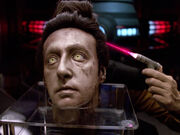
Data's head
In late 2368 , the Enterprise crew was summoned to San Francisco to evaluate a discovery of extraterrestrial life on Earth that dated back to the late 19th century . They were shocked to discover Data's head, old, dusty, and dead, had been found among the ruins of some 19th century artifacts. When La Forge concluded that the only species capable of time travel and of assuming Human form existed solely on the planet Devidia II , the Enterprise set course for the planetoid.
Data's head would have been about 475 years old when it was finally re-attached to his body in 2369.
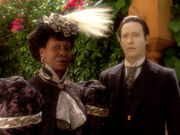
Data meeting Guinan on Earth in 1893 after he had seen her picture in a local newspaper
Arriving at Devidia II, Troi psionically sensed lifeforms, but none were seen to be physically present. Since Data was the only hope for controlling the distortion in phase displacement, he beamed down and soon disappeared, reappearing in the San Francisco of the late 1800s. He quickly adapted to his surroundings and set out to build a sensory device to sense the Devidian time-shifts in order to ultimately return to the 24th century and the Enterprise -D. Shortly thereafter, he incidentally met Guinan , who was hiding out from her father on Earth at the time.
Seeking to recover Data, the senior staff transported to 19th century San Francisco to find him. In a local morgue , Riker and Crusher realized the aliens from Devidia II, disguised as Humans, were slowly killing off the population by appropriating their neural energy and sending it to the 24th century to feed their own people. The Enterprise -D command crew were soon able to find and stop the Devidia II aliens. Even though Data's cranial unit had been severed from his body when he tried to control the Ophidian that controlled their time-travel technology, the crew were able to take Data's body back through the time-rift and use the cranial unit they had recovered from the Presidio mine site to reassemble Data (Data subsequently passing on a message from Picard that Picard had entered into his head in the past with an iron filing to tap out a binary code in his brain). ( TNG : " Time's Arrow ", " Time's Arrow, Part II ")
Later that year, Data and La Forge proposed to connect Data to the ship's systems so he might act as an emergency backup system in case of a ship-wide systems failure. As a result of the experiment, however, Lt. Worf , his son Alexander , and Counselor Troi were trapped in a malfunctioning Old West holodeck program wherein every character physically resembled Data. ( TNG : " A Fistful of Datas ")
The event was recalled by Beckett Mariner and Brad Boimler in 2381 when she suggested that they bury the evil computer AGIMUS , rather than taking him with him, "like Data's head." Boimler, corrected Mariner stating "actually, Data's head was in a cave, and it's our duty to respect sentient life. ( LD : " Where Pleasant Fountains Lie ")
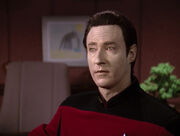
Data wore a command division uniform when Jellico made him XO
Captain Edward Jellico briefly took command of the Enterprise while Captain Picard participated in a covert mission in Cardassian space. Jellico came into conflict with Commander Riker and eventually relieved Riker of duty. Being next in the chain of command after Riker, Data took the position of first officer until Captain Picard's return. ( TNG : " Chain Of Command, Part II ")
In early 2370 , he was among the away team that beamed down to the Ohniaka III outpost , whose distress call the Enterprise had responded to. On the surface, Data experienced his first emotion while fighting off a Borg drone, violently beating the drone against the wall. With the captured drone Crosis , Data took a shuttlecraft and left the Enterprise . Captain Picard and an away team tracked Data down and were shocked to find him under the influence of his brother Lore, who had directed the Borg's attacks as part of an attempt to win Data to his side. Lore modified the chip so it could remotely instill anger and hatred in Data. Confused with his new emotions, and with his ethical program deactivated, Data betrayed the crew of the Enterprise , resulting in the capture of Picard, La Forge and Troi. Fortunately, La Forge was able to instruct Picard in modifying a Borg interlink transceiver to reset Data's ethical program with a kedion pulse , restoring his sense of right and wrong; he would still experience negative emotions, however, he could at least choose whether or not to act upon them. With Data's ethical program reactivated, and Riker and Worf leading a rescue attempt with the help of the drone Hugh (who had spent time aboard the Enterprise earlier that year) Picard and his team were able to reactivate Data's ethical program and Data subsequently shot Lore, recovering the emotion chip while Lore was later dismantled. ( TNG : " I Borg ", " Descent ", " Descent, Part II ")
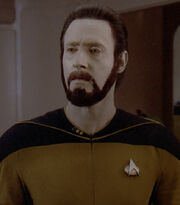
Data with a beard
Later that year, with Captain Picard presumed dead and Commander Riker missing in action, Data assumed command of the Enterprise once more, in an effort to find those responsible for Picard's apparent death and Riker's capture. Even though he was lower in rank, Lieutenant Worf was appointed as acting first officer instead of Lieutenant Commander La Forge, but Worf and Data came into a confrontation when Worf questioned his orders openly in front of the crew on a number of occasions. ( TNG : " Gambit, Part I ", " Gambit, Part II ")
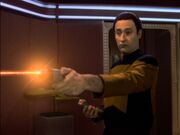
Data fires his phaser at Riker in 2370
After being sent to recover a crashed probe, Data lost his memory and sought refuge with primitive villagers nearby. He was quickly assimilated into the village and given the name "Jayden" by the villagers. However, the radioactive material from the probe that he was transporting was a danger to them. Even without his memory, Data, through observation and scientific method, discovered it was the metal he had brought with him that was the cause. Once he had the radioactive metal secured to prevent further harm, he came up with an antidote that would completely reverse the effects and while being confronted by the fearful villagers, dumped it into the local water supply. In their ignorance, they killed "Jayden" and buried him, but turned his grave into a commemorative monument in his honor after they realized his cure had saved them. Data was later retrieved by Commander Riker and Dr. Crusher, repaired and his memory was restored aboard the Enterprise , although his time on the planet was lost in turn. ( TNG : " Thine Own Self ")
Shortly after the incident, La Forge found behavior nodes in Data's positronic net and he thought that an alien "archive" was using Data to create different people and that this transformation was still going on. Counselor Troi added that Data was experiencing the android equivalent of "multiple personalities" and that it was indeterminate how many would emerge. Picard later confronted Data, through whom the D'Arsay Sun God of Masaka now spoke, wearing the mask of Korgano . Masaka thought she was alone and did not have to share the sky with anyone when Korgano told her that without him she was not complete. Korgano soon convinced Masaka was getting tired to brighten the sky forever. Masaka replied Korgano should begin the hunt again, and at that moment Masaka fell asleep. When Picard asked Data whether he was all right, Data answered he was not entirely certain what happened and wondered if he had been dreaming again. ( TNG : " Masks ")
Return to the emotion chip

Data laughs, his emotion chip installed
In 2371 , at the ceremony honoring Worf's promotion to Lieutenant Commander, Data witnessed an incident where Worf was "accidentally" sent into the water in a holographic simulation of a ship at sea. Misinterpreting the laughter it evoked, he then spontaneously pushed Dr. Beverly Crusher overboard. He was disheartened to find out that it wasn't quite as amusing as he had assumed. The incident led him to think his development had reached an impasse. This influenced Data's decision to install the emotion chip he had acquired from Lore previously that year.

Data sings a song while scanning for lifeforms
The results were unpredictable and later attributed to the overload of new and unfamiliar emotion. During an away mission with Geordi La Forge on board the Amargosa observatory , his recall of previous humorous incidents led to the emotion chip overloading, fusing into his neural net (much to La Forge's annoyance) and rendering Data helpless as Tolian Soran sneaked on board and kidnapped La Forge. Unable to deal with the sudden onset of fear as a result, Data curled up in a corner as Soran beamed away with La Forge. As the Enterprise investigated, Data was overcome by yet another emotion: Regret, over getting La Forge captured. Captain Jean-Luc Picard, himself trying to get over news of the death of his brother and nephew, helped Data get through his anguish, and the two managed to figure out where Soran was headed, and why.

Data celebrating after the victory at Veridian III

Data protecting Troi from falling debris on the Enterprise bridge
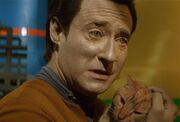
" I am happy to see Spot, yet I am crying. "
Upon arrival at planet Veridian III , where Soran was planning to implode the Veridian sun with a trilithium missile so that Soran could enter the Nexus , Data was finally able to experience relief as Geordi La Forge was returned to Enterprise unharmed. Data continued to work on controlling his emotions throughout the mission, Enterprise 's battle with the Duras sisters , and the crash landing of the saucer section on Veridian III. By the end of the mission, when Starfleet came to recover the Enterprise crew and anything that could be salvaged from the saucer section, Data reckoned to have experienced 261 distinct emotional states. He learned one more emotion before leaving Veridian III: Tears of joy, after finding Spot alive in an empty barrel. ( Star Trek Generations )
During the crash, Data utters a severe profanity, his first.
By 2373 , Data had developed the ability to activate and deactivate his emotion chip at will, since he had learned how to better control its function and integration into his positronic net. ( Star Trek: First Contact )
The Enterprise -E

Data captured by the Borg in 2373
Data transferred to the new USS Enterprise -E in 2372 , along with most of the senior staff of the Enterprise -D. In 2373 , the Enterprise took part in the Battle of Sector 001 , against Starfleet orders. Thanks to the ship's intervention, the Borg cube was destroyed, but not before it launched a sphere , which generated a temporal vortex and time-traveled to the year 2063 . The Enterprise pursued, and destroyed the sphere with quantum torpedoes preventing its forecast mission to prevent the first flight of Zefram Cochrane aboard the Phoenix warp ship. Along with Captain Picard and Dr. Crusher, Data beamed down to the surface, to inspect any damage to the Phoenix . Upon suspecting a Borg presence aboard the Enterprise , however, Picard and Data transported back to the ship. While fighting off the Borg near main engineering , Data was captured and brought before the Borg Queen . Instead of attempting to assimilate Data, she embarked on a transformative process to make Data more "Human," by attaching Human skin onto his android skeleton.
When it appeared impossible to deter the Borg any longer, Picard was persuaded by Lily Sloane to initiate the self-destruct of the Enterprise and he ordered all remaining crew to evacuate. However, Picard went to Engineering to find Data and to force the Queen, whom he had encountered several years previously when he was Locutus , to release Data. Picard even declared that he was prepared to take Data's place at the Queen's side and become her equal. However, Data stated he did not wish to go, even after the Queen ordered him away. Data then canceled the auto-destruct sequence and restored computer control; even as Picard begged him not to, the android gave one quick glance to his former commander, before walking past him as if he was nothing. Thus, the Queen ordered Picard's assimilation (Data assured her that Picard would "make an excellent drone"), but not before witnessing the destruction of the Phoenix by Data.

Data altered by the Borg Queen
However, his "assimilation" had all been a ruse – the quantum torpedoes fired by Data missed the Phoenix by the smallest of margins, and quickly thereafter Data ruptured a plasma coolant tank (the Queen had been too busy taunting Picard to notice his approach to it), releasing plasma coolant – which would dissolve organic material on contact. Picard was able to escape, but the Queen – or, at least, that version of her – was killed, pulled into the coolant by Data as she tried to take Picard down with her. Helping Data standing up (with the Borg-given skin melted away, but his mechanical parts undamaged, the android admitted that he didn't feel as bad as he must look), Picard asked him if he was ever tempted to join the Borg's cause. Data replied that, for 0.68 seconds, he was. He added that, for an android, that is "almost an eternity." ( Star Trek: First Contact )
The Ba'ku mission

Data on the Ba'ku planet
In 2375 , while assigned to a United Federation of Planets / Son'a duck blind operation on the Ba'ku planet , Data discovered a cloaked holoship submerged in a picturesque Ba'ku lake. The ship was intended as a means to relocate the Ba'ku people from their home world without their knowledge, clearing the way for the mining of metaphasic radiation from the planet's rings. Upon discovery of the cloaked ship, Data was fired upon by a Son'a weapon.
The attack resulted in minor physical damage to his neck and some of his memory engrams, causing Data's memory loss fail-safe system to activate. Data's ethical and moral subroutines asserted themselves over all his basic functions. Effectively, Data had entered a self-preservation mode in which "all" he knew was right and wrong. Before he was finally subdued by Captain Jean-Luc Picard and Lieutenant Commander Worf , Data had revealed the duck blind to the Ba'ku people, and had warned them that the Federation / Son'a presence was a threat – and attacked Ru'afo's flagship with the mission scout ship he hijacked.
The Enterprise crew was able to piece together what had happened – and staged an insurrection against the Federation-Son'a partnership. Data joined some of his crew mates as they defended the Ba'ku on the surface from aggressive Son'a abduction attempts. Later, Data attacked the Son'a flagship with a scoutship, firing tachyon bursts into the shield grid and forcing the ship to rotate its shield harmonics. This allowed the transport of the Son'a ship's crew off their bridge and onto the cloaked holoship.
During his time on Ba'ku, Data reflected on never having been a child. He became friends with Artim and learned how to play. ( Star Trek: Insurrection )
By 2379 , Data was expected to succeed Commander Riker as first officer following Riker's promotion to captain of the USS Titan . En route to Betazed for the second phase of Riker's wedding to Counselor Troi, the Enterprise discovered B-4 , one of the three prototype Soong-type androids Data had learned about years earlier, physically identical to him but having a less sophisticated positronic brain. Trying to help him become more Human, Data copied his own memories into B-4's positronic net.

Data sacrifices himself
Before Data could take the role of first officer of the Enterprise , the Enterprise was ordered to Romulus where a new praetor , Shinzon , had come to power . Shinzon's self-asserted good intentions, however, were soon found to be false. In reality, Shinzon was discovered to be a clone of Captain Picard and, due to genetic degeneration, he was in need of Picard's blood in order to restore his life. After Shinzon's vessel, the Scimitar , had all but destroyed the Enterprise , Shinzon planned to eliminate the crew with his thalaron radiation weapon before turning it on Earth. Though Picard was able to defeat Shinzon in hand-to-hand combat, Picard was trapped aboard the Scimitar due to damage to the Enterprise transporters. With no other option, Data elected to physically jump into the vacuum of space through a hull breach in the forward section of the Enterprise – and force his way aboard the Scimitar from the outside. Proceeding to the Scimitar bridge, Data utilized a prototype emergency transport unit concealed in his forearm, to return Picard to the Enterprise . With the thalaron radiation weapon seconds away from firing, Data used his phaser to destroy it, which resulted in the complete destruction of the Scimitar – and Data as well.
As the Enterprise crew mourned the loss of their fallen comrade, Captain Picard tried to explain Data's uniqueness to B-4, though to the captain's dejection, the android did not understand. However, B-4 soon began to quietly sing the same song Data had previously sung, "Blue Skies", at the Riker wedding to himself. Though Data was gone, perhaps his memories would continue to live on. ( Star Trek Nemesis )
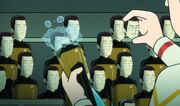
A crate containing bottles of Commander Data limited edition bubble bath (and one bottle with a Lore head)
At some point later in his career, Data was commemorated with a limited edition bubble bath ; the bottle of which bore his likeness, wearing a late 2370s uniform. A Lore edition was also released and its head could be surreptitiously substituted for that of Data's. ( LD : " An Embarrassment Of Dooplers ")

Data as he appeared in Picard's dream
Despite the android's best effort, Data's attempts to copy his own memories into B-4's positronic net ultimately failed, and as a result most of Data's positronic net was lost. B-4 was ultimately disassembled and preserved at the Daystrom Institute 's Division of Advanced Synthetic Research . ( PIC : " Remembrance ")
Data also briefly appeared to the Zhat Vash in the Admonition , an ancient storehouse of preserved memories on the planet Aia left behind by the Aia natives which warned about the dangers of intelligent synthetic life .
Approximately fifty years after his construction, Noonien Soong's son Altan Soong , assisted by Bruce Maddox, successfully created the Coppelius androids via the fractal neuronic cloning of one of Data's positronic neurons . Multiple androids were created as offspring of Data, including Beautiful Flower , twins Jana and Sutra , and twins Dahj and Soji Asha , of whom the latter four were also eventually created based on the likeness of his painting Daughter . ( PIC : " Broken Pieces ")

Data painting in Picard's other dream
Captain, and later Admiral, Picard continued to remember Data fondly. During his retirement, Picard had a series of recurring dreams in which he played poker with the android aboard the Enterprise -D. In 2399 , Picard had a dream of witnessing Data painting Daughter in the Picard family vineyards after he met Dahj. ( PIC : " Remembrance ", " Broken Pieces ")

The simulated Data prepares for the end
Despite the destruction of Data's physical form, the memories he uploaded into B-4 before his death as well as a single neuron were used by Bruce Maddox and reconstructed by Altan Soong, the biological son of his creator and "brother", to allow Data's consciousness to continue to exist in a massively complex quantum simulation. Because he had died after the upload to B-4, it was impossible for him to remember his death as that was not part of those memories, but he was aware of the death of his physical body and the circumstances in which he gave his life for Picard. Just as with Lore and B-4, Data considered Altan to be his brother as well.
In 2399 , Data encountered the consciousness of Jean-Luc Picard while his memories were in the process of being uploaded to Soong's golem . The two had a discussion in which Data confirmed he did not regret sacrificing his life for Picard and that he was aware of Picard's love and affection for him.
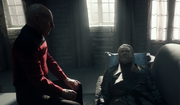
The simulated Data's final moments
As Picard was preparing to leave the simulation, Data made one last request to his old friend – that Picard terminate his consciousness. He explained to Picard that the finite nature of Human life helped define and give it meaning. Once Picard left the simulation, he complied with Data's request. As he deactivated the simulation, Picard postulated that despite the "violence and corruption and willful ignorance" of Humanity, Data was still able to see kindness, curiosity, and greatness of spirit possessed within the Human race, motivating his desire to be a part of the Human family. Data spent the time he had left enjoying a glass of wine, listening to " Blue Skies " on a record player , then reclining on a sofa until he rapidly aged and passed with a simulated Captain Picard, just as he was during the years on the Enterprise -D, by his side. ( PIC : " Et in Arcadia Ego, Part 2 ")
After another version of Data was resurrected as Daystrom Android M-5-10 , Picard recalled that the last time they spoke, this Data had expressed his wish to experience death, and hoped that, glad as everyone was to see him, they had not betrayed that wish. However, the new Data knew that this version of him was "resting peacefully" while the resurrected version of Data was glad to be back with his friends. ( PIC : " Surrender ")
A shared body
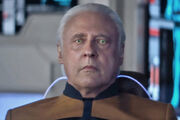
Daystrom Android M-5-10
After the ban on synthetics was lifted, Altan Soong began construction on a new golem that would serve as a 'totality', combining parts of B-4, Lore, Lal and a large amount of Data into a singular being. While everything that Data had copied to B-4 had previously been unsalvageable, the lifting of the ban gave Soong the chance to work on it more and finally extract Data from B-4 properly. This version of Data was a separate entity from the previous Data in the simulation rather than being the previous Data downloaded into the golem, lacking that Data's memories and referring to himself as a separate entity. Soong gave the new golem an older appearance, based on an aged Soong, hoping to reflect the wisdom of age. However, he died before he could complete the project and his work was seized by Section 31 and stored at Daystrom Station . ( PIC : " The Bounty ", " Surrender ")
This new Data was later rescued by an away team from the USS Titan -A while they were seeking information on the activities of Vadic and her Changelings . The integration of the personalities was not successful, and while B-4 and Soong were mostly dormant, Data and Lore were at odds with each other inside the golem. ( PIC : " Dominion ") The partition separating Data and Lore was later lowered, and despite Lore seeming to triumph, in taking Data's memories, Lore had effectively become Data himself, allowing Data to override Lore permanently and integrating elements of Lore's personality into himself. Data later stated that he was now Data, Lore, B-4, Lal and everything else that Soong had programed into the android. As part of the successful integration, Data's mannerisms became more Human than they had previously - for instance, Data started using contractions in his speech, and remarked that he could truly feel emotion. ( PIC : " Surrender ") With the renewed threat of the Borg , Data resumed his old post aboard the rebuilt USS Enterprise -D to save the Federation, playing a crucial role in the endeavor by flying the Enterprise -D through a seemingly impossible path on the inside of a Borg cube based on a gut feeling. ( PIC : " Võx ", " The Last Generation ")
Following the destruction of the Borg, Data began adjusting to his resurrection in an organic body and all of the emotions that came with it. ( PIC : " The Last Generation ")
Personal interests
Holodeck adventures.
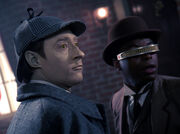
Data and La Forge in a Sherlock Holmes holonovel
Data was fond of Sherlock Holmes and enjoyed playing the great detective in a holodeck program, often accompanied by Geordi La Forge in the role of Dr. Watson. ( TNG : " Elementary, Dear Data ", " Ship In A Bottle ")
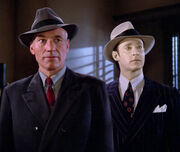
Picard and Data in " The Big Good-Bye "
Data also twice accompanied Picard in his holonovels of the Dixon Hill series , playing " Carlos , from South America," one of the private eye's associates. ( TNG : " The Big Goodbye ", " Manhunt ")
Data had been known to play poker with people from other time periods, including Stephen Hawking , Albert Einstein , and Sir Isaac Newton , out of interest as to how they would interact in such a situation. He called the exercise "most illuminating". ( TNG : " Descent ")
Data's love for holoprograms was inherited by Daystrom Android M-5-10 who used them to reach out to his friends. This helped Riker identify as Data as the one who was trying to contact them. ( PIC : " The Bounty ")
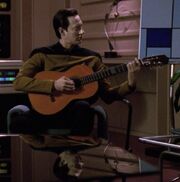
Data playing the guitar in 2368
Data pursued many of the higher arts of Earth . He developed his painting skills, creating art of many styles and subjects. ( TNG : " Birthright, Part I ", et al. ) He performed in plays and wrote poetry, although his lack of emotions meant that his poems commonly focused more on accurate poetical structure without the content evoking any kind of emotional reaction. ( TNG : " Schisms ", " The Defector ", " Frame of Mind ", " Emergence ") He played the violin and performed on several occasions. ( TNG : " Sarek ", " Tin Man ", et al. ) He also played classical guitar and the oboe . ( TNG : " Silicon Avatar ", " In Theory ") He dabbled in singing, most notably performing " Blue Skies " at William T. Riker and Deanna Troi 's wedding. ( Star Trek Nemesis )
Personal relationships
Friendships.
Data maintained close relationships with most of the Enterprise senior staff – during his time aboard the Jovis , after La Forge's furious refusal to accept that Data himself was somehow responsible for the shuttlecraft explosion that supposedly killed him, Riker told Captain Picard that, for someone incapable of emotion, he certainly evoked them strongly in others around him. ( TNG : " The Most Toys ")
Jean-Luc Picard
Data regarded Picard as something of a father figure throughout his service, asking for Picard's advice on numerous occasions in his quest to become more Human. Picard always gave Data advice whenever he could.
A similar relationship between a captain and an artificial member of the ship's crew was developed in Star Trek: Voyager between Captain Kathryn Janeway and The Doctor , Voyager 's Emergency Medical Hologram , who achieved sentience after he was forced to assume the permanent position of Voyager 's doctor after the deaths of the original medical staff.
Following Tasha Yar 's death in 2364 , Data was puzzled about her death, thinking not about Yar but rather how he would subsequently feel in her absence, thinking that he missed the purpose of her memorial but Picard assured him that he understood the purpose of the memorial perfectly. ( TNG : " Skin Of Evil ")
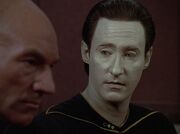
Data discussing his rights with Picard
In 2365 , Data's existence was threatened when Commander Maddox wished to disassemble and study Data to gain a better understanding of how his positronic brain functioned. Data refused to submit to Maddox's procedure, finding his research flawed but Maddox claimed that Data was property of Starfleet and therefore not a sentient being and as a result had no choice other than to submit to the procedure. Captain Louvois supported Maddox's claim and Picard intervened by challenging their reasoning, saying that Data was indeed sentient and deserved the freedom to make his own decisions. He also said that Data represented an entire race and that forcing him to submit to Maddox's procedure was tantamount to slavery – strictly prohibited under Federation law. Ultimately, Louvois sided with Picard's standpoint and agreed that Data, android or not, was indeed sentient and entitled to the same rights as any other Starfleet officer. ( TNG : " The Measure Of A Man ")
In 2367 , Picard's seemingly unbreakable trust in Data was tested when Data refused to fully co-operate in an investigation into a number of events that happened within a 24-hour time span although Data claimed that the time span was only thirty seconds. Data's intransigence threatened to end his Starfleet career and even his own existence but it was later revealed that Captain Picard was himself responsible for Data's unusual behavior after an encounter with the Paxans in a T-Tauri type star system. ( TNG : " Clues ")
During the Klingon Civil War from 2367-8, the Federation made an indirect intervention with a blockade of Starfleet vessels placed in formation to use the pioneering tachyon detection grid in an effort to expose Romulan support for the House of Duras . Picard assigned all of his senior officers positions on board other ships except for Data. Data questioned Picard about why he was not assigned command of a vessel considering that there was a severe lack of senior officers available for the mission, wondering if he felt that his being an android made him unsuitable for command. Picard, slightly embarrassed by Data's question, assigned Data command of the USS Sutherland . During the blockade Data disobeyed direct orders from Captain Picard and was able to expose the Romulan's involvement in the war. Data submitted himself for disciplinary action for disobeying a direct order from his superior officer but Picard praised Data for not following his orders as he believed that doing so was appropriate under the circumstances. ( TNG : " Redemption II ")
In 2369 , Data refused to allow a group of exocomps to be sacrificed in order to save the lives of Captain Picard and Lieutenant Commander La Forge, who were trapped on board the Tyrus VIIA station , believing that they were sentient and therefore capable of making their own decisions. After agreeing to a compromise suggested by Commander Riker, the exocomps were released and able to save the lives of Picard and La Forge. Picard understood the predicament that Data was faced with as he had defended Data's sentience just a few years previously but this time the exocomps had no advocate and Data felt compelled to act on their behalf. Picard considered Data's actions to be the most "Human" decision that he had ever made. ( TNG : " The Quality of Life ")
Later that year, following an accident in main engineering that activated a dormant program in his positronic brain , Data sought advice from several officers, including Captain Picard, on his "visions." Picard was curious why Data was studying thousands of different cultures to interpret his visions. Data said that he had no culture of his own but Picard told Data that he did have a culture; a culture of one and that its validity was no less than that of a billion. Picard suggested that Data should consider what the visions meant to him instead of what they meant to other people. ( TNG : " Birthright, Part I ")
After a malfunctioning emotion chip fused with Data's positronic net in 2371 , Data felt guilty for not saving La Forge from capture by Tolian Soran on board the Amargosa observatory . Data was overwhelmed by emotions and requested being shut down until the chip could be removed. Although Picard felt sympathy for Data, he told him that part of having emotions was integrating them into your life and learning to live with them and denied Data his request. ( Star Trek Generations )
In 2373 (when the Enterprise -E traveled back to the year 2063 on Earth ), Picard and Data initially went down to the planet to observe the damage the Borg had done to Zefram Cochrane 's missile complex in Montana . Down in the missile silo of the Phoenix , Picard, upon touching the missile that would make history by becoming the first Human starship traveling at warp , explained to Data that sometimes a touch can make objects more "real." Upon suspecting Borg presence aboard the Enterprise , Picard and Data transported back to the ship. Fighting off the Borg near main engineering, Data was soon captured and brought to the Borg Queen . Instead of attempting to assimilate Data, the Queen made him physically more Human by attaching Human skin onto his android skeleton.
When it appeared impossible to hold off the Borg any longer, Picard was convinced to initiate the Enterprise 's auto-destruct sequence and ordered all remaining crew to evacuate. He himself went on to engineering to find Data and to convince the Queen, who he had encountered several years previously, to let Data go. Picard was even prepared to take Data's place at the Queen's side, willingly, thus becoming her equal. However, Data claimed he did not wish to go; even after the Queen ordered him away. Thus, the Queen ordered Picard's assimilation, but not before witnessing the destruction of the Phoenix by Data.
Data fired a spread of quantum torpedoes but they missed by the smallest of margins, and quickly thereafter he burst a plasma coolant tank, releasing plasma coolant, which would liquefy organic material on contact, killing the Borg. The Queen was killed, but Picard survived. While helping Data to his feet, Picard asked him if he was ever tempted to join the Borg's cause. Data, hinting at his kiss with the Queen, replied that for a fraction of a second (zero point six eight seconds), he was. He added that for an android, this brief moment was like an eternity. ( Star Trek: First Contact )
Following the wedding of William Riker and Deanna Troi in 2379 , Data was confused by Captain Picard's mixed feelings for the couple – although the captain was happy that Riker was due to accept promotion to the rank of Captain and take command of the USS Titan and that his new wife was to transfer over to the Titan and take position as the ship's counselor , Picard was somewhat saddened by their departure and tried to explain to Data that experiencing feelings of both happiness and sadness at the same time are common in these situations.
At the climax of the Battle in the Bassen Rift , Data jumped across the void of space from the Enterprise -E to the Scimitar , saving Picard by using a prototype emergency transport unit but he sacrificed his own life to save the crew of the Enterprise by firing at the thalaron radiation generator and so destroying the Scimitar . Following the battle, Captain Picard held a toast with the Enterprise -E's senior officers as a tribute to their fallen comrade. ( Star Trek Nemesis )
Picard honored Data after his death with a toast with his senior staff. "To absent friends" is the same toast Kirk gives in Spock 's honor after his death. ( Star Trek III: The Search for Spock ; Star Trek Nemesis )
Twenty years after Data's death in the Bassen Rift, Picard encountered Data's preserved consciousness in a complex quantum simulation. As Data's sacrifice had greatly weighed on Picard's mind after all this time, Data reassured Picard that he did not regret sacrificing his life to save Picard. Before Picard was brought back, Data asked Picard for a final favor in terminating his consciousness, as he wished to live knowing that his life was finite. Picard honored the request, and within the simulation, a version of Captain Picard of the Enterprise -D remained at Data's side as he passed away. ( PIC : " Et in Arcadia Ego, Part 2 ")
Picard was later reunited with Data once again, this time more properly, after Dr. Altan Soong resurrected Data as Daystrom Android M-5-10 . Picard was pleased to be reunited with his old friend once again. ( PIC : " The Bounty ", " Dominion ", " Surrender ", " Võx ", " The Last Generation ")
William T. Riker
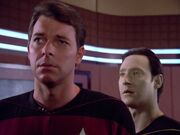
Data with Riker in 2364
William Riker first met Data on the Enterprise holodeck in 2364 . Data was trying to whistle " Pop Goes the Weasel ", but could not finish the last few notes. At Data's memorial service, Riker could not remember what song Data was trying to whistle. ( Star Trek Nemesis ) Riker helped him finish the tune, later giving Data the nickname " Pinocchio ", in reference to Data's wish to become Human. At first, Riker was skeptical about Data's abilities as a machine, assuming his rank of lieutenant commander was merely honorary. Despite Riker's misconception, Data had earned his rank, just as every other Starfleet officer of the same rank and above had done. ( TNG : " Encounter at Farpoint ")
In 2365 , Data's status as a sentient individual came into question. A hearing was held on Starbase 173 , but the base lacked a complete legal staff. As first officer of the Enterprise , Riker was forced to act as counsel for Bruce Maddox and was given the task of convincing Judge Phillipa Louvois that as an android, Data was the property of Starfleet. Riker very nearly proved that Data was property by means of deactivating him. Picard's defense later made Louvois hold that Data was a machine, was not the property of Starfleet, and had the right to choose whether to comply with Maddox's requests to study him. Riker was distressed over the incident, and he felt terrible that he had nearly cost Data his rights. Data did not hold any ill will towards Riker or Maddox; on the contrary, Data was actually grateful that Riker participated, telling Riker that if he did not, the initial ruling being appealed would have remained in Maddox's favor, and by Riker going against his conscience and potentially condemning his friend and colleague to be disassembled, that action wounded him in order to save Data's life, and was something Data would never forget. ( TNG : " The Measure Of A Man ")
Data sought Riker's help and advice on several occasions. One instance was when he asked for Riker's advice on friendship and betrayal, following a mission involving Ishara Yar in 2367 . ( TNG : " Legacy ") Data also asked for Riker's help when Keiko Ishikawa temporarily called off her wedding to Miles O'Brien in 2367 . ( TNG : " Data's Day ") He came to Riker once more for advice when he started to date Jenna D'Sora . ( TNG : " In Theory ")
In 2401 , Data inside of Daystrom Android M-5-10 reached out to Riker using holographic projections and music that Data had liked. Riker eventually figured it out and responded to Data with " Pop Goes the Weasel ." ( PIC : " The Bounty ")
Geordi La Forge
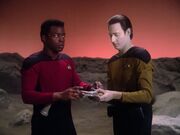
Data assists Geordi La Forge with his VISOR on Vagra II
Data's closest friend during his time aboard the Enterprise was Geordi La Forge. As of 2367, Data considered La Forge to be his best friend. ( TNG : " Data's Day ") Because Data was an android, La Forge was better equipped to effect repairs and maintenance on him than was Dr. Crusher as chief medical officer. Their long-term friendship dated back to 2364, when both were assigned as bridge officers aboard the vessel. La Forge's promotion to chief engineer the next year reflected his expertise with machinery, though he experienced difficulties in establishing relationships with other people, especially women. These personality traits may have accounted for La Forge's ability to so easily maintain a relationship with a sentient machine such as Data; that being said, La Forge never saw Data as an android or a machine per se, but as a close friend and treated him no differently than he would have if Data were a sentient biological organism. ( Star Trek Generations ; TNG : " Encounter at Farpoint ", " Code of Honor ", " Booby Trap ", " Galaxy's Child ", " Eye of the Beholder ")
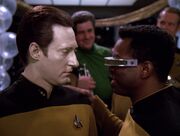
Data with La Forge at his memorial service
Their friendship was tested in early 2370 , during the Enterprise 's encounter with the individualized Borg. Lore used the emotion chip stolen from Dr. Noonien Soong to influence Data to join him, deactivating Data's ethical program and transmitting negative emotions (such as hatred, sadism, and anger) to Data. While under Lore's influence, Data participated in a neurological experiment with La Forge as the primary subject. The experiment caused La Forge a great deal of pain and would have eventually resulted in La Forge's death. Fortunately, Captain Picard and others of the Enterprise crew were able to reactivate Data's ethical program. It was Data's friendship with La Forge that eventually allowed the android to overcome his brother's influence. ( TNG : " Descent, Part II ")

La Forge reluctantly agreeing to install Data's emotion chip
In 2371 , following an incident on the holodeck in which Data pushed Dr. Crusher off a sailboat in the water, Data decided to finally have the emotion chip Dr. Soong gave him years earlier installed in his neural net. La Forge assisted Data by installing the chip after the latter made this life-changing decision, though La Forge later reacted negatively to his friend's erratic behavior that accompanied the initial acquisition of emotions. When La Forge was later threatened by Dr. Soran aboard the Amargosa observatory , Data was afraid to intervene, but he later learned to live with his newly acquired emotions. ( Star Trek Generations ) When Data secretly transported himself to the Scimitar to save Picard, La Forge helped him do it, knowing this would be the last time the friends would see each other. ( Star Trek Nemesis )
Data's death emotionally broke LaForge, but it was also the memory of him that allowed LaForge to pull himself back together, and believed their friendship had made him a better man and become a better father after his two daughters were born. The discovery of Daystrom Android M-5-10 in 2401 with Data's complete memory as recovered from B-4, allowed Data to reunite with LaForge and continue their friendship after decades apart. While fighting the Borg over Jupiter , Data asked to be allowed to fly the Enterprise through the Borg Queen's cube -- something that La Forge believed was impossible for even a computer or the best pilot -- based on Data's gut feeling that he could do it, echoing how La Forge had tried to teach Data to trust his gut. After a moment's hesitation, La Forge decided to go with Data's gut which proved to be the right decision as Data was able to fly the ship to the very heart of the cube so that the Enterprise could destroy it. ( PIC : " Dominion ", " Surrender ", " The Last Generation ")

Beverly Crusher
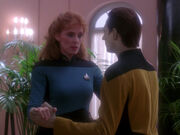
Crusher teaching Data to dance
Dr. Beverly Crusher and Data had a special relationship, with Data seeking advice from Crusher on subjects ranging from parenting ( TNG : " The Offspring ") to dancing. She taught Data to tap dance, not knowing that he had intended to learn how to dance for the wedding of Miles O'Brien and Keiko Ishikawa. ( TNG : " Data's Day ") Data also came to her for advice on whether or not to consider the exocomps alive, and she was present when Data learned they were indeed sentient. ( TNG : " The Quality of Life ")
As the ship's chief medical officer , Dr. Crusher had some knowledge of how to repair and "heal" Data, though mostly it was Geordi La Forge who filled that function, since Data was an artificial lifeform. ( TNG : " Datalore ", " The Game ")
In 2369 , Data incorporated a subroutine for small talk. At the recommendation of Captain Picard, he studied Commander Hutchinson while the Enterprise underwent a baryon sweep at Arkaria Base . Dr. Crusher was the first person Data tried to engage in small talk using his observations of Hutchinson, to her astonishment and delight. ( TNG : " Starship Mine ")
During Worf's promotion ceremony in 2371 , Dr. Crusher tried to explain to Data the humor behind Worf being dunked after walking the plank on the holodeck recreation of the sailing ship Enterprise . Data did not completely understand and then pushed Crusher into the water, as an attempt at the same type of humor. However, Dr. Crusher and the rest of the senior staff did not find it nearly as amusing. La Forge later recommended that Data stay out of sickbay for a few days following the ceremony. ( Star Trek Generations ) In 2379 , Dr. Crusher remarked that she thought Data had nicer eyes than his predecessor, B-4. ( Star Trek Nemesis )
Data enjoyed an excellent professional relationship and a solid, if low-key, friendship with the cantankerous Klingon. They had two important things in common: first, both were rescued by the Federation after their homes were destroyed by enemy attacks, instilling in each of them a high regard for the Federation's ideals. Second, both were Starfleet pioneers; Data and Worf were, respectively, the first android and Klingon Starfleet officers. Although most of their time together was in the line of duty (such as bridge duty and away missions), both were frequent participants in the senior staff's poker games, and they often spent time together off-duty in Ten Forward . Moreover, Worf was one of the only people that Spot , Data's cat, warmed up to, even though Worf was not fond of the feline.
When Data's shuttlecraft exploded while returning to the Enterprise -D in 2366 , all Worf could do was stare in shock at the viewscreen and mutter his friend's name. As it turned out, the explosion was staged in order to kidnap Data, and he was subsequently rescued. ( TNG : " The Most Toys ")
In 2367 , Data sought Worf's help in finding a wedding present for Miles and Keiko O'Brien . ( TNG : " Data's Day ")
When Geordi La Forge and Ensign Ro Laren were presumed dead in a transporter accident in 2368 , Data volunteered to arrange the memorial service, but he was unsure about what kind of ceremony to have and asked Worf for advice. Worf told him that for Klingons, an honorable death in the line of duty was a cause for celebration, not mourning. Data took his advice and arranged a very upbeat party, giving people the chance to share their pleasant memories of the 'deceased'. His arrangments were very well received by the crew, and was only enhanced when La Forge's and Ro's states were returned to normal. ( TNG : " The Next Phase ")
A year later, Data again sought Worf's guidance, this time in researching the "dreams" he was having. Worf, preoccupied with rumors that his father had survived the attack on Khitomer , gave Data some cryptic answers, but Data seemed to understand what he was saying and went on his way. Data later returned this favor when Worf learned that the apparently returned Kahless the Unforgettable was actually a clone of the legendary Klingon; Data's reflections about how, after learning of his android nature, he chose to consider himself a person who could progress and grow over time rather than a machine who would never be more than the sum of its parts, convinced Worf to accept Kahless as the symbol that he could be for his own people rather than define him by the circumstances of his origins. ( TNG : " Birthright, Part I ", " Rightful Heir ")
Their friendship was severely tested in 2370 when Data, acting as commanding officer, privately admonished Worf for challenging his orders in front of the bridge crew. Afterward, Data apologized to Worf if the dressing-down had ended their friendship, but Worf took the high road, saying that if the friendship was in jeopardy, it was his fault alone. After that exchange, their working and personal relationship quickly returned to normal. ( TNG : " Gambit, Part II ")
Katherine Pulaski
When Dr. Pulaski came aboard the Enterprise in 2365 , she was not very kind toward Data, because of her discomfort with technology. She saw him as no more than a machine, pronouncing his name "DAT-uh" rather than "DAY-ta," and did not understand that he had a preference. ( TNG : " The Child ") She was also condescending towards Data and often spoke to him through other crewmembers. ( TNG : " Where Silence Has Lease ") She believed that Data's methodical way of looking at situations meant that he could never solve a traditional Sherlock Holmes mystery, which led to the creation of the program which brought about the sentient Professor Moriarty. ( TNG : " Elementary, Dear Data ")
However, later during the year, she began to value Data and look upon him as an equal and as a sentient individual. The major turning point was during the crisis surrounding the Darwin Station children. Data stayed to support Pulaski for a long period of time after she had become infected, something for which she was very grateful. ( TNG : " Unnatural Selection ") Pulaski even challenged master Zakdorn strategist Sirna Kolrami to a game of Strategema , believing that Data could win. When Data was unsuccessful, he interpreted it as a possible weakness and relieved himself of duty. Dr. Pulaski talked to Data and made him realize that one letdown did not necessarily mean total failure and encouraged him to return to duty, but with no success. Finally, Captain Picard told Data that a loss can be had with no mistakes made and convinced him to return to duty. Data later forced Kolrami to a stalemate, much to Kolrami's chagrin. ( TNG : " Peak Performance ")
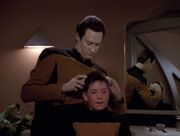
Data combing young Timothy's hair
Tasha Yar observed that Data viewed the world with the wonder of a child. ( TNG : " Skin Of Evil ") During his service Data had befriended several children. Data befriended an alien girl named Sarjenka in violation of the prime directive. To mitigate the damage, Picard ordered Dr. Pulaski to erase Sarjenka's memory. ( TNG : " Pen Pals ") Data befriended a ten-year-old boy named Timothy after Timothy was orphaned in the explosion that destroyed the Vico. Timothy wanted to be incapable of emotion like Data because he wrongfully blamed himself for the Vico's destruction, so he pretended to be an android and attempted to mimic Data in every way. ( TNG : " Hero Worship ") Data befriended an alien girl named Gia when he lost his memory on Barkon IV . This friendship was similar to his friendship with Sarjenka, only this time, it was Data who lost all memory of the friendship, and the child who would never forget him. ( TNG : " Thine Own Self ")
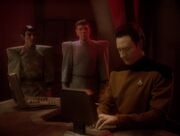
Spock offering his assistance to Data in 2368
As an unemotional member of the crew, and a respected advisor to the captain, Data shared many similarities to Spock on board the first USS Enterprise . However, where Spock often believed himself to be superior to Humans, Data aspired to be more Human (Data once stated that having no emotions made him closer to Vulcans than Humans, but he found their stark philosophy to be limited). The contrast between the two was instantly apparent to them when they met on Romulus . Spock noted that Data's complete lack of emotion and superior physical capabilities were qualities to which Vulcans aspired, but Data wished to be more Human. Data noted that as a half-Human, Spock abandoned what Data had sought his entire life by choosing the Vulcan way of life. ( TNG : " Unification I ", " Unification II ")
Data was programmed with multiple techniques and was "fully functional." Data had a sexual relationship with Natasha Yar during the influence of polywater intoxication and attempted a romantic relationship with Jenna D'Sora in late 2367 . ( TNG : " The Naked Now ", " In Theory ") In 2373 , the Borg Queen seduced him in an attempt to convince Data to join the Borg's cause. ( Star Trek: First Contact )
Natasha Yar
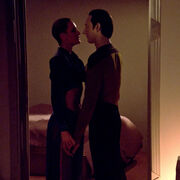
Tasha Yar and Data under the influence of polywater intoxication in 2364
Data had a short sexual relationship with Natasha Yar in 2364 . Yar was at least slightly attracted to Data and had sex with him while under the influence of polywater intoxication . She later told him that the incident "never happened." ( TNG : " The Naked Now ") Data, since he has perfect memory (he can remember everything that has ever happened to him like it just happened), still felt a special connection to Tasha. He kept a holographic image of Tasha to remember her after her death. When Data's rights as a sentient being were called into question, his romantic encounter with Tasha was a strong influence for Judge Phillipa Louvois to rule that Data was in fact a sentient lifeform. ( TNG : " The Measure Of A Man ") La Forge and Wesley Crusher found the holoimage when they visited Data's quarters after his apparent death in 2366 . ( TNG : " The Most Toys ")
Jenna D'Sora
In late 2367 , Lieutenant Jenna D'Sora found herself in love with Data. After she expressed her affection for him by kissing him on the lips, Data asked his friends for advice on what to do, and decided to pursue the relationship. Since he had no real emotions or feelings, Data created a special program in his neural net to guide him through the intricacies of love. However, as his relationship with Jenna progressed, Data discovered that in romance, the logical course is not always the most appropriate.
Later that year, they decided to end their relationship. D'Sora explained that her previous boyfriend had been unemotional, and felt that her choice of Data, an android completely incapable of emotion, indicated a pattern. Without a second thought, Data, seeing the validity of her point, agreed to discontinue his program. ( TNG : " In Theory ")
Data's comment to the Borg Queen in Star Trek: First Contact regarding how long it had been since he had last made use of his sexual functionality seems to indicate he was referring to his liaison with Tasha Yar. This implies that Jenna and Data were never physically intimate during the course of their relationship.
In 2063 , during the Borg attack on the Enterprise -E, which had arrived from the year 2373, Data was abducted by a Borg drone . Unable to assimilate the android, the Borg Queen attempted to bribe Data into subservience by offering him live flesh instead of his polymer. Data played along, having suggested sexual relations with the Borg Queen, who wanted him as a partner to ease the loneliness of her role as the one individual in the Collective, Data essentially 'replacing' Locutus. Data ultimately betrayed the Borg Queen, killing her with warp engine coolant, which also removed the new flesh she had grafted onto him. He subsequently admitted to Picard that a part of him was still sorry about her death, noting that her offer to bring him closer to Humanity had briefly tempted him (albeit for only 0.68 seconds, a duration that, according to Data, equates – for an android – to "nearly an eternity"). ( Star Trek: First Contact )
Alternate realities and timelines
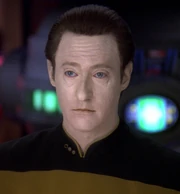
An alternate timeline where Data has blue eyes instead of his normal yellow.
In 2366 , the USS Enterprise -C emerged from a temporal rift . Its disappearance from the year 2344 caused an altered timeline, where the Federation was losing a war against the Klingons. Data was still the ship's operations officer. ( TNG : " Yesterday's Enterprise ")
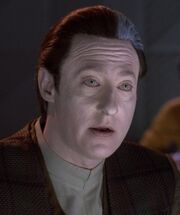
Data in an unknown future timeframe
In 2370 , Lieutenant Worf encountered a quantum fissure which caused him to begin shifting between quantum realities . In several universes, Data was still the Enterprise 's operations officer, and attended a surprise birthday party for Worf. In at least one of these realities, Data's eyes were blue instead of their characteristic yellow.
In another reality, Data was still the operations officer and second officer but was outranked by Commander Worf, who served as the ship's first officer under Captain Riker, Picard having been lost in the Battle of Wolf 359 in 2367 . He determined that the Worf from the primary reality did not belong in his reality as his quantum signature was not consistent with the resonance of matter in the rest of the universe and that he had originated from a different quantum universe. This version of Data theorized that it would be possible to seal the fissure if the shuttlecraft Curie from the primary reality re-entered the fissure and emitted a broad spectrum warp field . According to Captain Picard, the Data from the primary reality had reached the same conclusion. All the events following Worf's encounter were erased from the timeline once the fissure was sealed. ( TNG : " Parallels ")
In an unknown, alternate future timeframe , Data was a professor (the Lucasian Professor of Mathematics ) at Cambridge University and lived at Isaac Newton 's house with a housekeeper and several cats . Apparently in this future, he had grasped the concept of humor, stating that his housekeeper Jessel made him laugh. In addition, his everyday speech had much more nuance and inflection, and he appeared to have finally mastered the use of contractions. He had also dyed part of his hair grey as he believed that it made him look distinguished. However, Jessel was of the opinion that it made him look like a "bloody skunk ." ( TNG : " All Good Things... ")

Data as part of The Three Musketeers
Data was holographically duplicated on a number of occasions.
- Lt. Reginald Barclay in 2366 recreated at least two Datas when he was suffering from holo-addiction . One program had Data as part of The Three Musketeers , while the other recreated the entire crew of the Enterprise -D. That recreation of Data was present when Barclay said goodbye to his fantasies and deleted the programs. ( TNG : " Hollow Pursuits ")
- Barash recreated the entire command crew of the Enterprise -D in 2367 on Alpha Onias III to keep Commander Riker there. This recreation took place in a 2383 where Data had been promoted to Commander and had become the first officer . Inaccuracies of this holographic reproduction of Data, including inability to perform calculations at the speed of the real Data and the use of contractions in his speech, served to aid Riker in recognizing the holographic scenario as false. ( TNG : " Future Imperfect ")
- In 2369 , Geordi La Forge and Data attempted to establish an interface between Data and the Enterprise-D ’s computers so he could serve as a backup in case of a ship-wide systems failure. There was a power surge, which resulted in all the characters in the currently running Holodeck "Ancient West" Deadwood program taking on the appearance and abilities of Data. ( TNG : " A Fistful of Datas ")
Memorable quotes
" Do you consider yourself superior to Humans? " " I am superior, sir, in many ways. But I would gladly give it up, to be Human. " " Nice to meet you, Pinocchio ! " (Data looks perplexed) " A joke. " " Hm. Intriguing. " "You're going to be an interesting companion, Mr. Data. "
" He speaks the truth, sir. From your point of view, he is only a facsimile, a knock-off, a cheap imitation... " " ...thank you, Mr. Data. "
" 1 – 7 – 3 – 4 – 6 – 7 – 3 – 2 – 1 – 4 – 7 – 6 – Charlie – 3 – 2 – 7 – 8 – 9 – 7 – 7 – 7 – 6 – 4 – 3 – Tango – 7 – 3 – 2 – Victor – 7 – 3 – 1 – 1 – 7 – 8 – 8 – 8 – 7 – 3 – 2 – 4 – 7 – 6 – 7 – 8 – 9 – 7 – 6 – 4 – 3 – 7 – 6 – Lock. "
" I am not less perfect than Lore. "
" As I experience certain sensory input patterns, my mental pathways become accustomed to them. The input is eventually anticipated and even 'missed' when absent. "
" I could be chasing an untamed ornithoid without cause. " " A wild goose chase? "
" I never knew what a friend was, until I met Geordi. He spoke to me as though I were Human. He treated me no differently from anyone else. He accepted me for what I am. And that – I have learned – is friendship. "
" I am perceiving an apparent change in the way others behave toward me. "
" It is… it is… it is green. "
This was nearly the same line as Scott's description of a similar beverage to the Kelvan Tomar in TOS : " By Any Other Name ".
" I understand your dilemma. I once had what could be considered a crisis of the spirit. " " You? " " Yes. The Starfleet officers who first activated me on Omicron Theta told me I was an android, nothing more than a sophisticated machine with Human form. However I realised that if I were simply a machine, I could never be anything else. I could never grow beyond my programming. I found that difficult to accept, so I chose to believe that I was a person, that I had the potential to be more than a collection of circuits and sub-processors. It is a belief which I still hold. " " How did you come to your decision? " " I made a leap of faith . "
" I must admit, Data, I never get used to seeing you like this. " " I do not understand. You are constantly working on similar electronic systems, yet their appearances do not disturb you. " " But you're not just another electronic system. " " Thank you, Geordi. Nor are you just another biological organism. "
Appearances
- " Encounter at Farpoint "
- " The Naked Now "
- " Code of Honor "
- " The Last Outpost "
- " Where No One Has Gone Before "
- " Lonely Among Us "
- " Justice "
- " The Battle "
- " Hide And Q "
- " The Big Goodbye "
- " Datalore "
- " Angel One "
- " 11001001 "
- " Too Short A Season "
- " When The Bough Breaks "
- " Home Soil "
- " Coming of Age "
- " Heart of Glory "
- " The Arsenal of Freedom "
- " Symbiosis "
- " Skin Of Evil "
- " We'll Always Have Paris "
- " Conspiracy "
- " The Neutral Zone "
- " The Child "
- " Where Silence Has Lease "
- " Elementary, Dear Data "
- " The Outrageous Okona "
- " Loud As A Whisper "
- " The Schizoid Man "
- " Unnatural Selection "
- " A Matter Of Honor "
- " The Measure Of A Man "
- " The Dauphin "
- " Contagion "
- " The Royale "
- " Time Squared "
- " The Icarus Factor "
- " Pen Pals "
- " Samaritan Snare "
- " Up The Long Ladder "
- " Manhunt "
- " The Emissary "
- " Peak Performance "
- " Shades of Gray "
- " Evolution "
- " The Ensigns of Command "
- " The Survivors "
- " Who Watches The Watchers "
- " The Bonding "
- " Booby Trap "
- " The Enemy "
- " The Price "
- " The Vengeance Factor "
- " The Defector "
- " The Hunted "
- " The High Ground "
- " A Matter of Perspective "
- " Yesterday's Enterprise "
- " The Offspring "
- " Sins of The Father "
- " Allegiance "
- " Captain's Holiday "
- " Tin Man "
- " Hollow Pursuits "
- " The Most Toys "
- " Ménage à Troi "
- " Transfigurations "
- " The Best of Both Worlds "
- " The Best of Both Worlds, Part II "
- " Brothers "
- " Suddenly Human "
- " Remember Me "
- " Reunion "
- " Future Imperfect "
- " Final Mission "
- " The Loss "
- " Data's Day "
- " The Wounded "
- " Devil's Due "
- " First Contact "
- " Galaxy's Child "
- " Night Terrors "
- " Identity Crisis "
- " The Nth Degree "
- " The Drumhead "
- " Half a Life "
- " The Host "
- " The Mind's Eye "
- " In Theory "
- " Redemption "
- " Redemption II "
- " Ensign Ro "
- " Silicon Avatar "
- " Disaster "
- " The Game "
- " Unification I "
- " Unification II "
- " A Matter Of Time "
- " New Ground "
- " Hero Worship "
- " Violations "
- " The Masterpiece Society "
- " Conundrum "
- " Power Play "
- " The Outcast "
- " Cause And Effect "
- " The First Duty "
- " Cost Of Living "
- " The Perfect Mate "
- " Imaginary Friend "
- " The Next Phase "
- " The Inner Light "
- " Time's Arrow "
- " Time's Arrow, Part II "
- " Realm Of Fear "
- " Man Of The People "
- " Schisms "
- " Rascals "
- " A Fistful of Datas "
- " The Quality of Life "
- " Chain Of Command, Part I "
- " Chain Of Command, Part II "
- " Ship In A Bottle "
- " Face Of The Enemy "
- " Tapestry "
- " Birthright, Part I "
- " Birthright, Part II "
- " Starship Mine "
- " Lessons "
- " The Chase "
- " Frame of Mind " ( hallucination )
- " Suspicions "
- " Rightful Heir "
- " Second Chances "
- " Timescape "
- " Descent "
- " Descent, Part II "
- " Liaisons "
- " Interface "
- " Gambit, Part I "
- " Gambit, Part II "
- " Phantasms "
- " Dark Page "
- " Attached "
- " Force of Nature "
- " Inheritance "
- " Parallels "
- " The Pegasus "
- " Homeward "
- " Sub Rosa "
- " Lower Decks "
- " Thine Own Self "
- " Eye of the Beholder "
- " Genesis "
- " Journey's End "
- " Firstborn "
- " Bloodlines "
- " Emergence "
- " Preemptive Strike "
- " All Good Things... "
- Star Trek Generations
- Star Trek: First Contact
- Star Trek: Insurrection
- Star Trek Nemesis
- ENT : " These Are the Voyages... " (voice only)
- " Remembrance " (dreams only) (Season 1)
- " Broken Pieces " (vision only)
- " Et in Arcadia Ego, Part 1 " (vision only)
- " Et in Arcadia Ego, Part 2 "
- " The Bounty " (archive footage) (Season 3)
- " An Embarrassment Of Dooplers " (likeness on bubble bath bottle)
- " Reflections " (likeness on bubble bath bottle)
Background information
Data was played by actor Brent Spiner in all of the character's television and film appearances. The character of Data appeared in all episodes of Star Trek: The Next Generation , with the exception of season four 's " Family ". He also appeared in all four TNG-era Star Trek films . In 2005 , Spiner recorded a brief, voice-only cameo as Data for the final episode of Star Trek: Enterprise , " These Are the Voyages... ": Data was heard speaking to Deanna Troi over a com-link (for which Spiner was not credited). Spiner had previously played Arik Soong , an ancestor of Data's creator, in a 2004 story arc on Enterprise . In 2020 , Data appeared in four episodes of Star Trek: Picard , albeit only in dreams and visions and as a version of Data's personality downloaded into B-4 prior to the actual Data's death in Nemesis .
According to the Star Trek: The Next Generation Companion , 2nd ed., p. 15, Data was inspired by The Questor Tapes , a movie created for television created by Gene Roddenberry and Gene Coon during the 1970s . It featured Robert Foxworth as the title character (as well as including Majel Barrett and Walter Koenig ), and was intended as the pilot for a series which would have detailed the adventures of an android with a childlike personality.
However, Susan Sackett felt Data was more consciously inspired by Spock than by Questor. She commented, " Gene was always fascinated by artificial intelligence . Data was sort of like the Spock character who could be logical and see things in a different way. The difference is this one wants to be Human, unlike Spock, who did not want to be Human. I don't think he was consciously thinking of The Questor Tapes." ( The Fifty-Year Mission: The Next 25 Years , p. 58)
The Vulcan character of Xon from the aborted Star Trek: Phase II television series has also been noted as a "forerunner" or "early version" of Data, including by Judith and Garfield Reeves-Stevens . ( Star Trek Phase II: The Lost Series , p. 28) In particular, they highlighted the similarity of the two characters' efforts "to replicate Human behavior without being able to understand it." ( Star Trek Phase II: The Lost Series , p. 83)
Wherever Roddenberry's thoughts lay in creating Data, Robert H. Justman concurred that such an android character would be a boon for the series. " I thought we could establish a new series 'regular' – an android programmed by Starfleet Command with all of the familiar abilities and characteristics of Spock fused with the leadership and humanistic qualities of Captain Kirk , " Justman recalled. " A new character like this would give us any number of dramatic or humorous avenues. " ( The Fifty-Year Mission: The Next 25 Years , p. 58)
Rick Berman observed that Data was similar to multiple other fictional characters. " He was a little like the characters in The Wizard of Oz , " Berman pointed out. " He wanted to be a real boy, like Pinocchio , but he also he wanted to have a heart, wanted to have a brain. " ( The Fifty-Year Mission: The Next 25 Years , p. 96)
According to Melinda M. Snodgrass , Data wasn't just similar to characters from child fiction but was extremely child-like himself. " I've always used Data as the child, " Snodgrass commented. " Data is exploring what any child does as they grow up. You can allow Data to make a mistake, learn from it, and rectify it in a way that if you have someone else to make that mistake, it seems unbelievable because these are such highly trained professionals. " ( The Fifty-Year Mission: The Next 25 Years , pp. 96-97)
The March 1987 TNG Writers/Directors Guide provided a backstory for Data that was jettisoned rather quickly during the series. In that version, he had been manufactured by highly advanced, but never seen, aliens who placed into him all the memories of a doomed "Earth-Asian" space colony to preserve their existence. His personality would thus have been influenced by the colonists. Elements of this backstory, such as Data retaining the memories of a group of colonists, survive in a version of his backstory established in " Datalore ".
Robert Justman reckoned there were "several ways to go" when casting Data and took inspiration, in this regard, from actor Lance Henriksen 's portrayal of the android Bishop in the film Aliens . ( The Fifty-Year Mission: The Next 25 Years , p. 58) Among the performers who were considered to portray Data were John Lone , Robert Englund , actress Kim Miyori ( Creating the Next Generation ), Mark Lindsay Chapman , Kevin Peter Hall , Eric Menyuk , and Kelvin Han Yee . The latter four were being considered as of 13 April 1987 , at which point Chapman was regarded as seemingly the favorite choice for the part. [1]
When Brent Spiner won the part of Data, he was anxious about how much it would allow him to do. " Initially when I took the part, my biggest fear was that it was going to be the most limited character, not only on the show but on television, because the canvas on which I was being allowed to paint was such a narrow one, " Spiner explained. ( The Fifty-Year Mission: The Next 25 Years , p. 96)
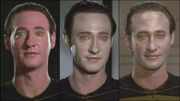
Becoming Data, bit by bit
When Gene Roddenberry cast Brent Spiner in the part of Data, the android's appearance was not yet determined. Spiner went through thirty-six makeup tests, as makeup artist Michael Westmore painted him an enormous variety of colors, including bubblegum pink and battleship gray. The preproduction personnel finally settled upon bright gold, with yellow irised contacts. Spiner was opposed to the idea of wearing makeup for his character at first. " My argument with Gene was, 'If you could make a creature that moves like this and looks like this and thinks like this, why can't you do the skin?' And Gene's response was, 'What makes you think what you have isn't better than skin?' And that's very difficult to argue with. " ( Trek: The Next Generation Crew Book )
In his portrayal of Data, Brent Spiner drew his inspiration from two different sources. The first was taken from Riker's reference to Data as Pinocchio in " Encounter at Farpoint ", a comparison which he used in his portrayal. " He's a machine who'd love to be Human, and is fascinated by Humans, " Spiner observed. " I suppose in his journey he'll get closer and closer to being one. " The second was the Blade Runner character Roy Batty , as according to Spiner, " I like to think of myself as the Rutger Hauer of this show, " adding, " but then I like to think of myself as Rutger Hauer in real life: strikingly handsome, irresistible to women, an intergalactic enigma. " ( Trek: The Next Generation Crew Book )
Brent Spiner's portrayal of Data had an effect on the number of stories featuring him, as Rick Berman pointed out: " Brent was so good at it that all the writers felt a great desire to want to write for that character. " As a result, Spiner himself was delighted to find his "biggest fear", that Data would be quite a limited role, wasn't being realized. " It was incredible for me […] I just lucked into a part that turned into the most unlimited role on television, " Spiner enthused. ( The Fifty-Year Mission: The Next 25 Years , p. 96)
In "The Questor Tapes," Questor was to have experimented with sexuality, making love to a female character. Network censors did not allow this scene to be used in the film, but a decade later, more relaxed standards allowed an "intimate relationship" to occur between Data and Tasha Yar in " The Naked Now ". Data's assurance that he is a "fully functional" Human male is a quote from the telemovie. A scene from " The Royale " wherein Data repairs loaded dice is also from The Questor Tapes . [2]
The ending for Star Trek Nemesis suggested that B-4 may become a replacement for Data, thus possibly becoming Data in the process and mirroring Spock's rebirth and the allusions to it at the end of Star Trek II: The Wrath of Khan . However, Spiner noted that he had visibly aged out of the role and that it would be implausible for him to continue playing an android whose appearance should not change with time (though the seventh-season episode " Inheritance " establishes that Data has an aging program that ages his appearance, and "All Good Things…" shows an appearance-aged Data). Hence, B-4's presence (and the suggestion that he has a copy of Data's memories stored) was most likely meant to have been a tease.
Other than in alternate realities, Data has always appeared as a lieutenant commander throughout the entire run of TNG and the subsequent movies. Jean-Luc Picard and Beverly Crusher are the only other characters to remain at the rank they started with. Data was also one of the few non-Vulcans to master the Vulcan nerve pinch on-screen, as seen in " Unification II " and Star Trek Nemesis .
A reference to Data is made in the VOY Season 2 episode " Prototype " by B'Elanna Torres when she is conversing with Automated Unit 3947 . While assisting him in developing a prototype robot capable of using a uniform power module, Torres describes Data as the only truly sentient artificial life-form in her culture while 3947 reflects that he would be interested to meet a machine with equal status to a "Builder".
On 9 April 2008 , the character of Data was inducted into Carnegie Mellon University's Robot Hall of Fame. Attending the ceremony on the android's behalf was Spock actor and Carnegie Mellon alumni Zachary Quinto . [3]
In 2016 , Brent Spiner expressed a willingness to pass on the portrayal of Data, saying, " I don't think I'll get proprietorial about it. I'd like to see Tilda Swinton play Data. Don't you think that'd be cool? " ( SFX , issue 275, p. 67)
Academy graduation inconsistency
In " Encounter at Farpoint ", Data says he graduated with the Starfleet Academy Class of '78, despite the facts that the episode took place in 2364 and Data was assembled in the late 2330s . In the extended cut of " The Measure Of A Man ", it was established that Data was admitted to the Academy in 2344 and graduated in 2348. Later, for his personnel file in " Conundrum ", these dates were changed to 2341 and 2345.
Use of contractions
Data's tendency to avoid the use of verbal contractions in ordinary speech is remarked upon in " Datalore " and " Future Imperfect ". While episodes preceding "Datalore" routinely show his use of contractions, this rule was adhered to for most of the remainder of the series with some notable exceptions. These can be categorized in one of three broad ways: as a single instance not commented upon during the episode, as part of portraying a new character or persona, or to denote some future change or enhancement to his original programming.
- In " Encounter at Farpoint ", Data tells McCoy, " I'm an android, " and later, about Q, he says, " At least we're acquainted with the judge. "
- In " Where No One Has Gone Before ", he says, " It's off the scale, " when referring to the ship's velocity and " We're here… " as an explanation as to why the Enterprise should stay and study the galaxy M-33 .
- In " The Arsenal of Freedom ", after destroying one of several weapons, Data says to Yar, "must've".
- In " We'll Always Have Paris ", three versions of Data are figuring out which of them is in the correct time continuum. The correct Data concludes aloud "it's me!"
- In " Manhunt ", when Captain Picard summons Data to Lwaxana Troi's boudoir to help him escape from an awkward situation, Data replies, " I'm on my way. "
- In " Elementary, Dear Data ", Data asks La Forge to open the door to the drawing room, saying, " Let's not keep the inspector waiting. "
- In " Shades of Gray ", Data says to La Forge, " I'm always careful. " He also appears to say "you're" seconds later.
- At the end of " Datalore ", Data tells Wesley Crusher , " I'm fine, " and in " We'll Always Have Paris ", he makes the remark, " It's me. "
- During the teaser of " The Naked Now ", Data uses contractions several times, including " What we've just heard is impossible " and " I'm sure he meant now. "
- In " The Last Outpost ", Data states, " Captain, this shouldn't be " and " I'm afraid not. "
- In Star Trek: Insurrection , he remarks to a child that " You'll be safer. " This is said in a rushed, seemingly emotional tone. But is after Data receives his emotion chip.
- In " The Big Goodbye ", Data appears to be able to use contractions with ease on several occasions while participating "in character" during the Dixon Hill simulation on the holodeck.
- In " Data's Day ", Data says to Troi, " In an effort to be helpful, I'm attempting to calculate the variables of a successful marriage. " Later, in the transporter room, Data says, " There's no record… "
- During " In Theory ", while creating a new program for use during a romantic relationship, Data utilizes the phrases " Honey, I'm home! ", " I'll join you ", and " You're not my mother! " When questioned about the last's apparent angry nature, Data reverts to a more characteristic response of " You are not my mother. " It is implied that Data was trying to act like "role models" he had found in the ship's computer.
- In " The Next Phase ", while telling a transporter chief to use a console on the bridge to scan for energy fields, Data says he will modify an emitter to "eliminate the fields, once they've been isolated."
- In " Time's Arrow ", when asked by the bellboy Jack London what the machine he's building is "gonna be", Data responds hesitantly, " What do you think it is… gonna be? "
- In " Inheritance ", when updating Commander Riker regarding their status, Data says " we'll be returning to the beam out point shortly. "
- For the alternate future timeline version in " All Good Things... " and for all of the TNG films , Data is shown using contractions.
In fact, "Datalore" did not explicitly assert that Data was incapable of using contractions, merely that he generally did not use them, and that his tendency was to "use language… formally." In " The Offspring ", Lal's ability to use contractions is depicted as an advancement beyond Data's abilities, but Data's actual words are that he has not "mastered" their use. Given the above instances, it is clear Data is capable of using contractions as an affectation. Perhaps what he had not "mastered" was the ability to use them spontaneously, in everyday speech.
Upon her death in "The Offspring", Data downloads Lal's programming and memory records into his own positronic matrix, so that she need not be completely "lost." Given her apparent "mastery" of spontaneous contraction use during her brief life, this may further explain Data's liberal use of contractions beyond 2366.
In the "Special Crew Profile: Lt. Cmdr. Data" in the TNG Season 6 DVD special features, Data's occasional use of contractions is pointed out as often being an error in the script – the writers would often mistakenly write them in or miss them in edits – or that Spiner would slip up on his lines and use the more natural contraction rather than Data's formal speech patterns.
The version of Data restored to life in a new android body , having fully reintegrated and asserted his own personality while incorporating elements and mannerisms from Lore, Altan Soong, Lal, and B-4, routinely used contractions from that point forward. ( PIC : " Surrender ")
Data's backstory from the March 1987 TNG Writer's/Director's Guide made it into David Gerrold's novelization of Encounter at Farpoint .
The graphic novel The Gorn Crisis showed Data during the Dominion War , where he was able to help the Federation forge an alliance with the Gorn in 2375 , defeating a Gorn leader in combat and thus demonstrating that Human ingenuity was superior and stronger than the Gorn.
The novel The Buried Age explores Data's first encounter with Picard, with Picard encouraging Data to assert himself and work beyond what his superiors request of him; prior to meeting Picard, Data had shown a lack of career advancement because he always did the job in front of him simply because it didn't occur to him to push himself further or ask for particular assignments over others, adhering to the chain of command without thinking of going beyond the rules. As a result of his actions in the novel, where he uncovers and averts attempts to sabotage the under-construction Galaxy -class starships as an ancient alien implants subtle flaws in their design specs, Data is promoted to lieutenant commander and offered a place on a Galaxy -class ship when they are completed.
The TNG Relaunch novel Resistance follows up the question of whether B-4 would become Data, when Picard and La Forge are forced to deactivate B-4 and send him away for analysis, having accepted that the moments where B-4 showed access to Data's memories were merely random occurrences rather than any sign that he had definitively progressed. However, the later novel Greater than the Sum establishes that the Federation Council overturned the decision and granted B-4 the right to choose his own fate.
Data is resurrected in the novel Cold Equations : The Persistence of Memory , when Doctor Soong – who survived his death by transferring his mind into an android body far more Human in appearance than Data's – transfers Data's memories from B-4 into his own body, unable to complete the new body he had been attempting to construct due to the recent Borg invasion and a sudden attack from the Breen . Although Data does not consider himself to have been "resurrected" – citing, as an example, his reluctance to return to Starfleet now that he possesses his father's memories and understands how Soong felt at the idea of Data not continuing his work – La Forge concludes that he is still Data in every way that matters, citing their continued friendship and Data's predisposition to not use contractions even when capable of doing so as proof.
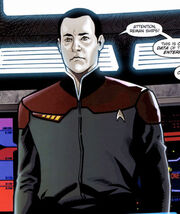
Captain Data of the USS Enterprise -E
The comic book series Star Trek: Countdown , a tie-in to the 2009 Star Trek film, depicts Data as alive in 2387 , having successfully imprinted his neural nets onto B-4's programming; at one point, Spock , who was also brought back to life after dying, makes a note of the incredibly unique life experience the two share. In the comic, Data had become captain of the Enterprise -E; along with Captain Picard, his face is seen in the film's comic adaptation , in which the Delta Vega mind meld scene is depicted with a collage of images from Countdown . This promotion to captain is one of the pieces of trivia that appears on loading screens in Star Trek Online . The short story "Unexpected Honor", appearing in Star Trek Magazine issue 167 (pp. 90-93) in 2012 , shows Data's captaincy ending with the Enterprise -E's destruction at the hands of the Undine in 2408; afterwards, Data retires from Starfleet to teach at the University of Oxford , a possible nod to the anti-time future in " All Good Things... " where he also became a university professor after leaving Starfleet.
In the short story "Our Million-Year Mission" from the anthology book Strange New Worlds VI set a million years in the future, Data Soong is a crewmember aboard the UberEnterprise , a ship populated by holographic replicas of famous Starfleet officers. He has modified himself to be able to experience every nuance of Human emotion as well as many alien ones.
In The Autobiography of Jean-Luc Picard , Picard and B-4 were paid a visit by Q shortly after the Enterprise -E returned to Earth following the battle with Shinzon. Over the objections of Picard, Q restored Data to life in B-4's body.
- Jayden , identity while amnesiac
- Carlos , a persona in the holodeck
External links
- Data at Wikipedia
- Data at Memory Beta , the wiki for licensed Star Trek works
- Data at the Star Trek Online Wiki
- 1 Daniels (Crewman)
- 2 Star Trek: Prodigy
- 3 James B. Sikking
'Picard’ Season 3 Showrunner Terry Matalas Breaks Down Episode 6, Data's Return, and the TNG Reunion
Your changes have been saved
Email Is sent
Please verify your email address.
You’ve reached your account maximum for followed topics.
‘RHOC’ Star Finalizes Divorce With 6-Figure Settlement
'ncis' season 22 just got an exciting update, spooky season is covered with these amc horror titles coming to netflix.
The sixth episode of Star Trek: Picard 's third and final season reunites Picard ( Patrick Stewart ), Riker ( Jonathan Frakes ), and Beverly ( Gates McFadden ) with three familiar faces from The Next Generation , as Worf ( Michael Dorn ) and Raffi ( Michelle Hurd ) board the Titan to track down more clues about the Changeling plot on Daystrom. It's there that Riker, Worf, and Raffi discover that a version of Data ( Brent Spiner ) is being used to store information, while Picard and the crew of the Titan head to the Fleet Museum in hopes that Geordi La Forge ( LeVar Burton ) may be able to help them escape the clutches of the Changeling-filled Starfleet that is after them .
Ahead of the premiere of Episode 6 , Collider had the opportunity to speak with Picard 's showrunner Terry Matalas about everything that went down in the episode, from Geordi La Forge's return, to Jack's grim diagnosis, what Brent Spiner contribute to Data's return, where things are headed with Vadic's plan, what's next for Raffi and Seven's ( Jeri Ryan ) relationship, and a whole host of other juicy tidbits about how "Bounty" came together.
COLLIDER: So one of the big revelations in this episode is Jack having Irumodic Syndrome like his father. I really like the way that this really connects to a lot of the larger themes of this episode about the things that parents pass on to their children, both good and bad, personality traits, all that. It's a very meaty story that's kind of unfolding. But I also really liked how we see Beverly, Jack, and Picard all react to this diagnosis in very different ways, like they're going through the different stages of processing this. What went into the decision for how each of them would react? Because Beverly feels very practical, very doctor, reporting the diagnosis. You have Jack that's like, "I'm hitting the bar," and then you have Picard that seems a little bit more unmoored by this because there's a guilt associated with it.
TERRY MATALAS: I mean, I think you just summed it up perfectly. I mean, that is exactly it. I think Beverly is trying to be as practical and look for a way to diagnose it and then treat it. Jack, on one hand, is relieved that it's not insanity, and now has something that he can point to, but also has resentment that he can also point to because it is that he can point to his father after all. And Picard has guilt. It comes from him. He finally got to this place of acceptance that he has a son, and he immediately found that he's passed this thing onto him, and he sees his son is not handling it particularly well. However, by the end of the episode, I think they both come to a nice place with it. I love this episode.
I love, also, just the themes of what we pass on and the themes of evolution and the themes even from the La Forge family. It all came together better than we could even imagine in every way in performance, symphonically with the music. I think LeVar is extraordinary. I think Mica, his daughter who comes on, is wonderful. I think Ashlei is phenomenal in that scene with LeVar. And Brent is extraordinary as the five different versions of Datas and Soongs. And yeah, we're really proud of this one.
I have questions for every single thing you just mentioned. There's so much that happens in this episode, and I think I've re-watched this three or four times at this point, and I'm really continually impressed by how much is in this episode, like, trying to come up with which questions to ask is there's so much that happens and it's all done so well. It's the best usage of time that I've seen in an episode of television in a very long time. But what goes into it from the creative standpoint of maximizing the time that you have, like making sure you hit every point? What happens in the writer's room? I'm sure people are always curious about how things evolve in the writer's room.
MATALAS: I mean, that's a tough question. I mean, this particular writing staff who I've had, many of these writers who have come with me throughout the years from 12 Monkeys , we're super ambitious. So we like to pack a lot in, and we'll know if we're successful early on in the first couple drafts, or if something's got to come away. But the good news about this one is, every one of these stories were all on theme. They were all telling a version of the same story of what we pass on from one generation to the next, including the setting itself of it being a museum, or being a Section 31 experimental archive. As long as the emotion of these characters is working– when you read it, if it's emotionally satisfying in the story, then I feel like we've done our job.
It works really well. There are so many moving pieces, and they all fit together like a puzzle, which I think is why a lot of people are going to be really excited about this being the episode that brings Geordi in. I know a lot of people have been really anxious about seeing his character, and this really feels like the midpoint of the story. You get this great connection with what's happening with Picard and Jack, and then you have Geordi learning through his daughter, which is such a beautiful thing to see, and recognizing that he needs to get involved in this. So I really love how all of that plays out. What was it like getting to bring LeVar back, and getting to play into this beautiful story of fatherhood, and daughters, and fathers and sons? It's so beautiful.
MATALAS: It was amazing. It was absolutely amazing. He loved every minute of it. Having his actual daughter there in those scenes, passing the torch from one generation to the next, right there in front of us was special to him and to us. So, it was incredible. It was really incredible. And he's never been better too. To meet this version of Geordi who is older, confident, is fully formed, has a family, has his own responsibilities, is not under the shadow of the Enterprise, and in the command of Jean-Luc Picard, it's so interesting. Watching LeVar just dominate those scenes, it takes your breath away.
Well, that's what’s made it so fun to watch these characters from The Next Generation cast reunite. They've all found their own place in the universe, and now they're trying to figure out how to fit back together as this crew. And they do fall back into things really well, but it takes time. Sometimes you see, in other shows, where they bring back characters, and it feels like no time has passed in a way that doesn't benefit the story, and this just works really well. I have to say that, not only is it fun watching LeVar and his daughter get to be on-screen together, that moment at New York Comic-Con where it was announced that she was going to be playing his daughter was such a special moment because, like you said, it's the passing of the torch. It's very fun to see this happen within the Star Trek family, so to speak. I also really love that Shaw, who has been so disillusioned by all of these legendary characters—
MATALAS: The only one he is impressed by is Geordi La Forge, the engineer.
Beautiful . I thought that was beautiful payoff. I hope that more people continue to like Shaw because he is quickly becoming one of my favorites. The Next Generation cast has spent a lot of time together over the years at conventions and various things. They still kept in touch. They still had those moments together in real life, but it's fun to see them getting to come back together after this time has passed. I wondered, did they get to come up with how their characters would hug or handshake, or how those reunion moments would work? Or is that really in the script, and then it just evolved? How did that come to be? Because I love that moment in the transporter room.
MATALAS: Well, that was in the script, the moment is there. How they pace it and the actual physicality is all them, but the moment itself was definitely written.
Speaking of the evolution of characters over time, we have, finally, this reunion between Raffi and Seven. Maybe I'm missing something, but I feel like at the end of Season 2, they weren't in a terrible place, but now they're like awkward exes. Are we going to see more of what happened in that in-between time, or get more of these moments between the two of them? Because I know people love them.
MATALAS: Raffi and Seven are on a journey this season. Their romantic relationship is certainly on a pause so that they could focus on their careers in this moment, but they will always be family. But I think fans of Raffi and Seven will find their journey worthwhile by the end.
That actually ties into another question that I had about the themes of the crew with the family, and I really love that moment. I feel like a broken record, but there are so many moments I love in these first six episodes I've seen, but I really love that moment with Jack and Seven on the Bridge looking at the ships. That was the moment where I was like, I want Seven to be his cool aunt figure, cool older sister figure. It was such a fun moment.
MATALAS: Totally.
What has it been like getting to really explore the crew as the family theme that we're seeing through this? We've seen it in other Star Trek series, but there feels like something really poignant in Picard with the way that this story feels like it's headed, where things are coming to a close. What has been like getting to unpack all of that with these different characters who have had really strong connections to their crews?
MATALAS: Well, I think that's what Star Trek is all about. It certainly, to me, is what it was going back to the original series on. So, it's just reflecting all of the great Star Trek narratives for me. And in that moment, specifically, those aren't ships that they're looking at, they're homes. It's easy for nihilist fans to say, "Oh, they're tossing out some nostalgia member berries." But really, they're not looking just at some starships. [They] are looking at the homes of different incarnations of Star Trek .
I love that moment. I love seeing the Voyager . It made me feel the warm and tinglies, but then you also are getting this great moment with both of them and both of their personalities, and they play off each other so well. It's a really fun moment.
MATALAS: They have great chemistry.
I feel like I have not talked about any of the stuff that has happened over on Daystrom, but the Moriarty reveal is really fun. It's something that we saw in, I think, the first trailer that dropped, it's a really fun connection. Are we going to see more cameos that haven't been revealed yet? Are there more things that we should be anticipating? Obviously not what are they, but will there be?
MATALAS: Yes.
I also really appreciate how Picard , throughout all three seasons, has found ways to incorporate Brent Spiner and Data in very fun, very creative ways that allow him to be a part of this plot. And you know, found another really fun one with this. Can you talk a little bit more about bringing him back? And are we going to get more of these moments like with Geordi where it’s the pure elation of seeing Data again? Are we going to get more of these moments of the Data and the crew?
MATALAS: One of the first questions I had to ask myself was, "How the hell are you going to do a Star Trek: Next Generation reunion without Data being a part of it?" This character has died twice, and you can't just bring him magically back to life. Something else has to happen. However, there are some stories that haven't really been told with Data, which is he was backed up onto B-4. Lore is still a dangling chad. What if there was a final android that was almost perfectly human in the way that Soji or Picard was, that could look like Brent Spiner today?
But what if it was Jekyll and Hyde? What if both Lore and Data [were] in there with all these other things? Wouldn't that give Brent Spiner something really interesting to play? And couldn't that promise a really interesting final Data/Lore story? I took that to Brent thinking he was going to reject the whole thing, and he was like, "Oh, that's actually really cool." Brent was unbelievably collaborative with it, and Brent had ideas that only elevated it in ways I couldn't have imagined. In fact, some of the best moments of this story were Brent's idea.
What we've seen so far has been great! I also love the way that this episode incorporated an actual flashback to The Next Generation I thought was a really fun callback. I was curious, are we going to see more of those, or is this just a special occasion because of the situation that they were in?
MATALAS: You might see a flash of something.
I've obviously watched The Next Generation a few times in my life, but it's nice to actually visually see the moment that's being called back. Because then I don't have to go to YouTube or Paramount+ to try to find the clip that's being referenced.
MATALAS: It bridges the two together in a really beautiful way. That's Jonathan Frakes, that's Brent Spiner. These are the moments that we're talking about.
In the process of bringing that footage in, was there any amount of restoration to the footage that had to be done to fit new standards of television? Because things have obviously evolved a little bit. Now we're watching it on little computer screens.
MATALAS: I think we did a little bit of noise reduction and some color timing to it. I think we cleaned it up a little bit, but not much.
We also get in this episode a hint that maybe Vadic has her own agenda, which I thought was really neat. How long do we have to wait to see a payoff of that?
MATALAS: The next episode is all about Vadic's backstory. That's my tease. You're going to know everything you want to know about Vadic in the next episode.
There are a lot of brilliant moments in this episode, as I've said, but I love Deanna showing up at the end, being the payoff of, I'm assuming this Vadic's quest to find people related to this crew, to torment them in new ways. That moment was great. I was curious, and maybe this is too soon to ask this, but are we going to get any payoff at all for that very oft-forgotten connection between Deanna and Riker, which is that they have telepathy? I saw, I think it was Frakes that mentioned it in an interview that he did, and it got me thinking about that again. Are we going to see any hints of that?
MATALAS: I would say the answer is: keep watching.
Can we expect more of Picard's associates and his crew's associates to potentially get pulled into this whole thing that Vadic is pulling?
MATALAS: There will be other people. Yes and no.
Are there any Easter eggs in this episode that we should keep our eyes out for?
MATALAS: Oh my God, this episode's chock-full of Easter eggs.
Maybe a favorite?
MATALAS: My favorite Easter egg is probably the body of James T. Kirk.
And the Tribbles?
MATALAS: The Attack Tribbles.
Attack Tribbles! I don't know if you've seen the Mirror Universe Tribbles toy that came out a few years ago, but they have terrifying teeth, and I was like, "Is that what that is?"
MATALAS: No, this is some genetically enhanced thing. I don't know what they were doing, but they shouldn't be.
It was terrifying. Do you have any favorite moments in this episode? Which I feel is a hard question to ask with this episode.
MATALAS: I have so many. I love Jack and Seven looking at the ships. I love Shaw and Geordi. I love when both Picard and Geordi realize it's their kids that had stolen the device at the same exact moment, “Jack.” “Sidney.” I love the Titan decloaking and coming to the rescue. I love Riker taking the punch at the end, and saying, "Ooh, look at you. How much of that goo shit did they pour into you?" He's just like Indiana Jones. He's fantastic. I have so many. I love LeVar and Sidney's scene, you know, "You taught me that, you taught me to believe in family, that the crew is my family." I love this episode, one of my favorites.
So what can you tease, aside from Vadic and her backstory, for Episode 7?
MATALAS: Things are about to get a whole lot worse.
The first six episodes of Star Trek: Picard 's third and final season is streaming now on Paramount+.
- Star Trek: Picard (2020)
“It was more appealing to me”: Star Trek: Picard Abandoning Data’s Most Unique Feature is Why Brent Spiner Agreed to Return
The Independence Day star reportedly hated sitting hours under makeup during TNG.
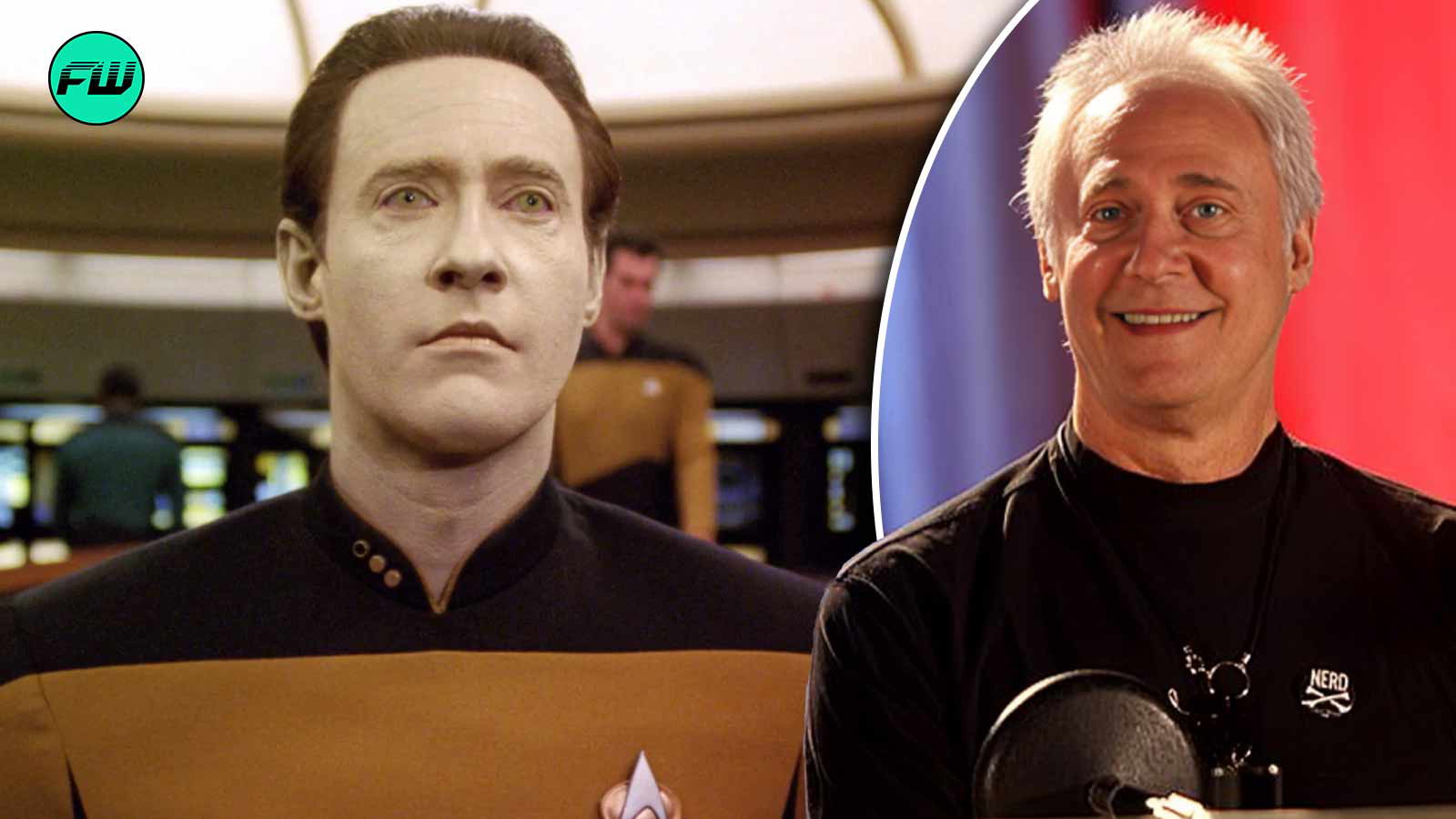
- Brent Spiner is known for playing Data in Star Trek: The Next Generation and the subsequent original films with the same cast.
- Spiner returned to the role in Star Trek: Picard and had a different arc where he and his evil twin Lore merged.
- The actor reportedly mentioned that he agreed to return after the makers said that Data's characteristic yellow makeup would be done away with.
The new generation series Star Trek: Picard brought back many fan-favorite characters from The Next Generation , including Sir Patrick Stewart and Brent Spiner’s Data. The latter especially was a surprise to fans as he was shown to have sacrificed himself in the last original film Star Trek: Nemesis .
While Spiner had reportedly refused to return to the series, he was convinced by one key aspect of the new show. He mentioned that the chance to not spend hours in his signature yellow/gold makeup and removing it was an appealing factor for him to return.
Brent Spiner’s Disregard For Data’s Yellow Makeup Brought Him Back To Star Trek: Picard
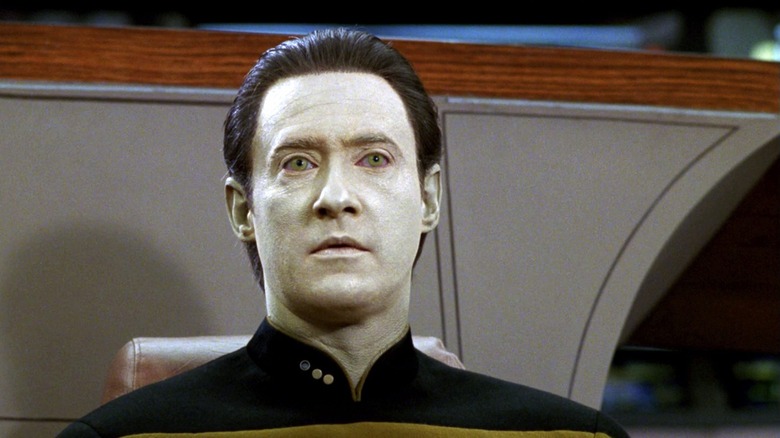
Both Sir Patrick Stewart and Brent Spiner had not been a part of any subsequent Star Trek material after the end of TNG and the films. Unlike actors like LeVar Burton and Jonathan Frakes, Spinner did not come back to the franchise in the form of a director. He even mentioned in 2018 that he was too old to return as Data as the character does not age.
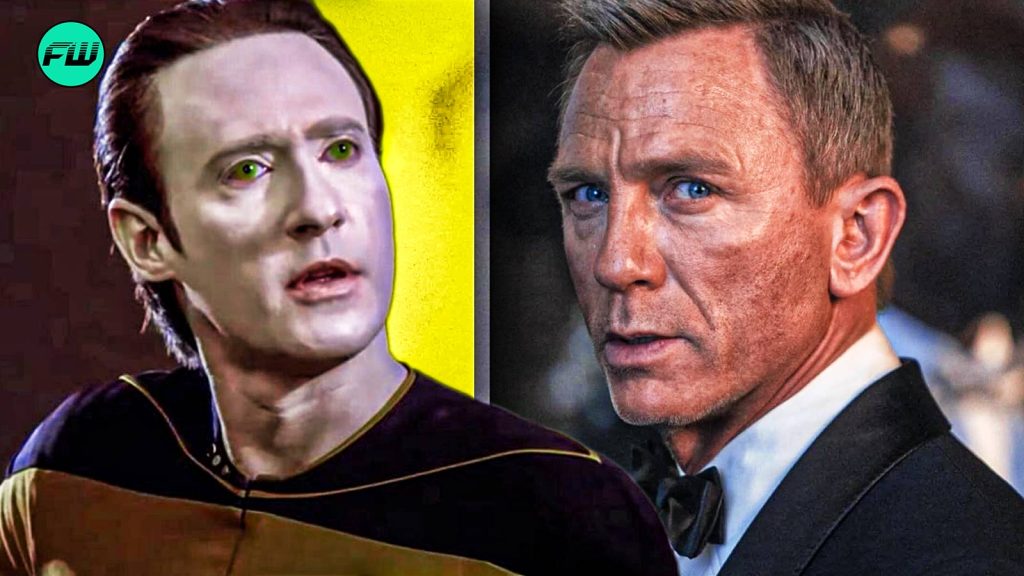
“It’s going to piss off people”: The James Bond Actor Brent Spiner Wanted to Play Jean-Luc Picard in His Star Trek: The Next Generation Spinoff
However, the actor was reportedly convinced to reprise his role by the studio in Star Trek: Picard . The spinoff show saw many of TNG characters such as Captain Picard, William Riker, Geordi LaForge, and others return after decades, and the makers even found a way to bring Data back from the dead (after the events of Nemesis ).

Spiner mentioned in an interview with TrekMovie that not having to sit for that yellow makeup was a huge win for him and the deal was insanely attractive. He said,
You know, [the makeup] wasn’t a big factor in convincing me to do it, although I was happy beyond belief not to wear the makeup. I mean, I still have the eyes. Yeah, certainly, it was more appealing to me knowing that I wasn’t going to be spending hours and hours and hours in makeup, and even worse, hours getting it off.
As Data returns in a more human-like form, the yellow/gold makeup was done away with in Star Trek: Picard but the actor had to still wear his signature golden eyes.
Brent Spiner Said That The Studio Threw A Ridiculous Amount Of Money At Him To Return
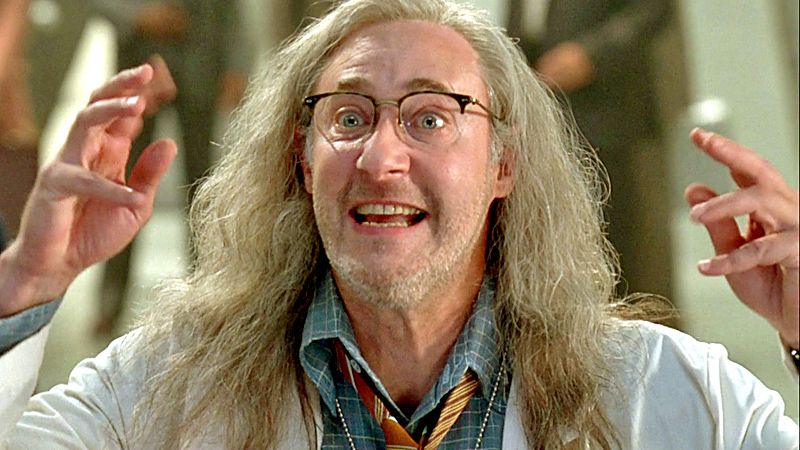
Brent Spine r is no stranger to reprising his classic roles. While he was one of the few actors from Roland Emmerich’s Independence Day to return in the 2016 sequel, he was reportedly not that keen on coming back to Star Trek . The actor mentioned to Yahoo! News that he felt he looked ridiculous in the makeup and he was too old for the role.
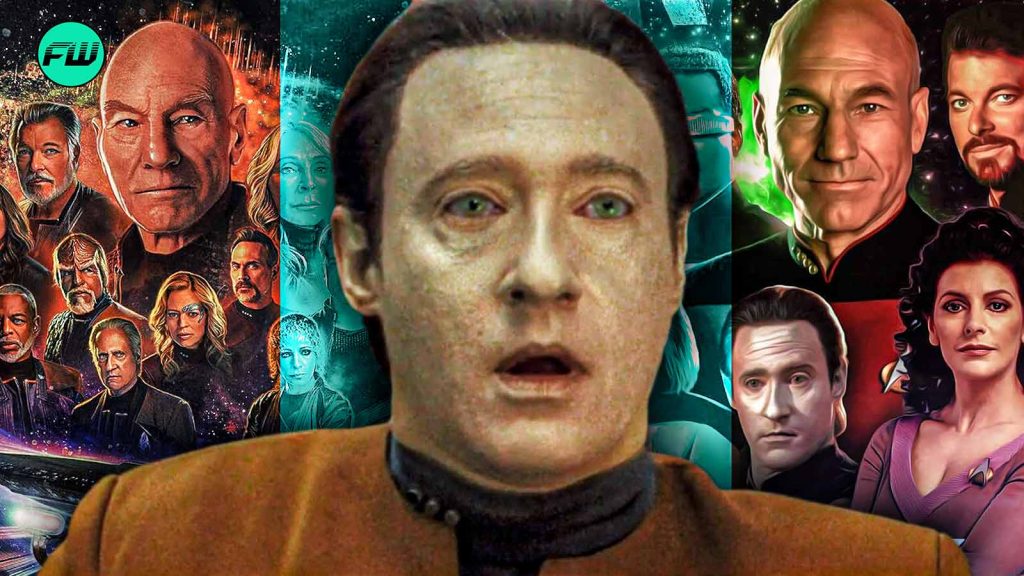
“This is the best work I’ve ever seen him do”: Brent Spiner on The Star Trek Co-Star Who Did a Much Better Job on Picard Than in The Next Generation
However, the studio reportedly removed both of those obstacles and made him an offer that he could not refuse to return as Data in Star Trek: Picard . He said to TrekMovie,
They just threw hundreds of thousands of dollars at me. I kept saying, ‘No, no, no.’ And then it just got absurd and I said, ‘Well, okay, maybe one episode,’ and then it just got even crazier. And I thought, ‘Okay, I’ll do the whole season.’ In fact, Terry had some interesting ideas and had a way to address them–my first response to him was, ‘How are we going to do this?’ And they came up with this stuff and we tweaked it a bit and then I thought, ‘Yeah, I want to be there to play with my friends.”’I wouldn’t want to be home knowing they’re all having that fun and I’m not there.
While he only had a brief role in season one, Spinner had an emotionally charged sequence in season three where Data and Lore merged into one and finally came back to life.
Star Trek: Picard is available to stream on Paramount+.
Brent Spiner
Written by Nishanth A
Nishanth A is a Media, English and Psychology graduate from Bangalore. He is an avid DC fanboy and loves the films of Christopher Nolan. He has published over 1,000 articles on FandomWire. When he's not fixating on the entire filmography of a director, he tries to write and direct films.
Copyright © 2024 FandomWire, LLC. All rights reserved.
Data Had An Entirely Different Backstory Planned Before Star Trek's Datalore
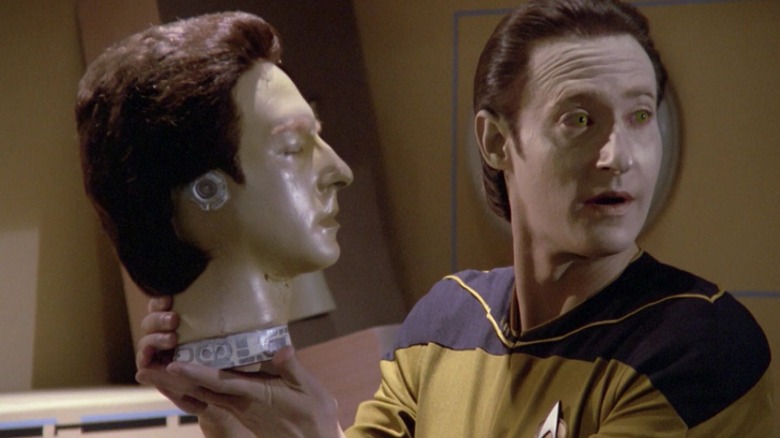
In the "Star Trek: The Next Generation" episode "Datalore" (January 18, 1988), the Enterprise-D is called to a distant colony where the android Data (Brent Spiner) was found years earlier. When Data was first discovered, he had no memories, although he knew he was constructed by a rogue genius named Dr. Noonien Soong. Soong was blackballed from the scientific community many decades earlier and had to retire to a distant colony to continue his work. Back when Data was discovered, by a starship called the U.S.S. Tripoli, the colony had been destroyed and Soong was missing, presumed dead. Data had no memories of what happened.
In "Datalore," the Enterprise found something else surviving among the rubble. Pieces of a second android, identical to Data, were found in a previously sealed area. Data and the Enterprise engineers reassemble it and find that it is Lore (also Spiner), another Soong android. Lore, unlike Data, is passionately emotional, and even a little sarcastic. He claims to be the secondary Soong model after Data proved to be imperfect. Data is keen to learn more about his origins from Lore.
Perhaps predictably, Lore turns out to be a liar and a villain. He was long in league with a massive crystalline entity that ate planets and lured the creature to his colony to eat up his human counterparts. He aimed to supplant Data and punish him for "dad always like you best" reasons. All Trekkies know Data's origin.
According to Larry Nemecek's invaluable sourcebook "The Star Trek: The Next Generation Companion," however, Data's origins used to be far different. During the early development of "Next Generation," Data was to have been built by an unknown race of space aliens.
The lore of Data
In some of the earliest production notes for "Star Trek: The Next Generation," written back in 1987, Data was described as having been built by a species of aliens that audiences would never see. The aliens were described as "Earth Asian," and Data was intended to be played by an Asian actor. Actor Kelvin Han Yee famously auditioned for the role. John Lone was briefly in consideration as was Kim Miyori, back when Data was (very briefly) transformed into a female character. The final audition actually came down to Spiner and Mark Lindsay Chapman. When Spiner was selected, only then did the physical design for Data begin in earnest. Makeup artist Michael Westmore was the one who invented Data's pale skin and yellow eyes.
The aliens who built Data would have also implanted his brain with the memories of their homeworld, and Data would have an amalgamated personality of every surviving member of the species, now presumably lost forever. That's an ambitious sci-fi idea, but perhaps difficult to portray in an everyday performance on primetime TV. That kind of concept is far better suited for sci-fi literature.
Some of that origin story made its way into the script for "Datalore." By on-screen Trek mythology, Data actually did have the personal logs of the lost members of his "childhood" colony implanted into his positronic brain. Data, however, had no emotions, and could only access the logs when asked. The colonists' memories didn't dictate his personality. Also, they were all humans in the final draft. No aliens in sight. Well, other than the crystalline entity that killed them.
The writers of "Star Trek: The Next Generation" adored Data, and the character got more "starring" scripts than any other character, save Captain Picard (Patrick Stewart). Spiner was also eager to stretch past playing a Pinocchio-like emotionless character, and was happy to play an "evil" character like Lore. Spiner would also eventually appear as the very elderly Dr. Soong in the episode "Brothers" (October 8, 1990). In that episode, it was explained that Lore was the imperfect prototype, and Data was the improved version. That knowledge gave Data an android version of a catharsis.
Spiner would also play multiple Data-like versions of Old West characters, thanks to a holodeck glitch, as well as another Soong prototype called B-4, introduced in the 2002 movie "Star Trek: Nemesis." Spiner played multiple members of Soong's extended family, stretching across a century, thanks to "Star Trek: Enterprise" (set about 200 years before "Next Generation") and "Star Trek: Picard" (set several decades after). His final form, from "Picard," was a super-advanced, mostly organic android with all the memories of Data, Lore, B-4, Soong, and others forced into his brain.
A few other androids have appeared since the inception of Data, but fewer than you might think. Thanks to the episode "The Measure of a Man" (February 13, 1989), wherein Data's sentience was put on trial, both fictional Starfleet officers and very real Trekkies have been cautious about manufacturing new living, artificial beings. It's also been repeatedly established that building a Soong-type android is very difficult, assuring that "Star Trek" wouldn't be overrun with androids. The stinginess paid off, and Data has remained a standout across the franchise.

Star Trek fans react as ‘most despised character’ returns for spin-off series
Star Trek fans are reacting to the return of the franchise’s most divisive character.
In recent year,s fans have been treated to several spin-offs, including Star Trek Discovery and Star Trek: Picard , starring Sir Patrick Stewart . Now, Star Trek: Prodigy – an animated series created by Kevin and Dan Hageman – is whetting the appetite of Trekkies.
The series follows a group of young aliens in the 24th century who find the abandoned starship Protostar and learn about Starfleet, and the ninth episode of its second season, which was released on Paramount+ earlier this month, featured a surprise in the form of an unexpected cameo.
*Spoilers follow – you have been warned*
In the episode titled “The Devourer of All Things, Part 1”, Wesley Crusher ( Stand by Me actor Wil Wheaton) returns.
Wheaton first appeared as the character in Star Trek: The Next Generation when he was 15, and returned in 2002 film Star Trek: Nemesis .
Wesley faced criticism from Star Trek fans, with some branding his boy genius character, who was actively disliked byJean-Luc Picard, “the most despised character” in the franchise’s history.
Wheaton himself said of the negative response to his character: “When I was younger, people gave me such a hard time about Wesley Crusher, there was a time in my late teens and early twenties when I resented Star Trek.
“It felt so unfair that people who had never met me were so cruel and hateful toward me as a person because they didn’t like a character I played on a TV show, I wanted to put Star Trek behind me and forget that it was ever part of my life.”
However, reaction to the Starfleet officer-turned-Traveller has turned around in recent years, with many fans happy to see Wheaton show up in the second season of Star Trek: Picard – but this excitement was short-lived as Wheaton was not invited back for the show’s third and final season.
Fortunately, Trekkies did not have long to wait to see Wesley again: he plays an important role in a rescue mission depicted in animated spin-off Star Trek: Prodigy – and in one scene, is shown to visit his mother, fan favourite character Beverly (Gates McFadden).
Fans are celebrating his return – which is shocking long-time fans who are yet to realise the fandom now supports Wesley.
One fan wrote: ““We were all disappointed that Wesley Crusher wasn’t in #StarTrekPicard season 3 after he cameoed in season 2’s finale. Thank the Travelers #StarTrekProdigy had something way better in the works!
Another bemused viewer wrote: “Insane to say that Wesley Crusher in Prodigy had the best legacy character subplot than any of the other TNG characters did in Picard .”
This was concurred by one Trekkie, who wrote on X/Twitter: “Imagine being told 10 years ago that the best new serialised season of Star Trek was going to be about Wesley Crusher helping a bunch of kids save Chakotay from being erased from the timeline
From news to politics, travel to sport, culture to climate – The Independent has a host of free newsletters to suit your interests. To find the stories you want to read, and more, in your inbox, click here .

William Shatner Shares Why He Doesn't Watch 'Star Trek' and If He's Open to a Possible Return (Exclusive)
William shatner shares his favorite memories from ‘star trek’ | tv greats, bob newhart's 'george & leo' co-star judd hirsch shares sweet memory with late actor (exclusive), kate hudson confesses she and matthew mcconaughey don't wear deodorant, aanvi kamdar, travel influencer, dead after falling into gorge while filming ig video, 'cobra kai' cast and crew share what's next after the final season (exclusive), lou dobbs, veteran news anchor and political commentator, dead at 78, jennie garth says shannen doherty and luke perry's deaths have made her feel same 'pain' and 'grief', 'cobra kai' cast offers advice to their younger characters (exclusive), whoopi goldberg reveals she secretly scattered mom's ashes inside a disneyland ride, 'young sheldon's iain armitage meets montana jordan's baby and pays homage to 'big bang theory', kim kardashian opens up about son's rare skin disorder, angelina jolie asks brad pitt to ‘end the fighting’ and drop lawsuit against her, mama june’s husband justin is pissed after she throws surprise vow renewal ceremony (exclusive), paris hilton and nicole richie filming ‘the simple life’ 20-year reunion special, madonna reveals biopic is back in the works after being scrapped 2 years ago, michael strahan's 19-year-old daughter isabella reveals she’s cancer-free, xolo maridueña reveals unexpected skill he learned on 'cobra kai' (exclusive), reign disick grossed out by kourtney kardashian and travis barker's pda, 'cobra kai' cast share special skills they picked up filming netflix hit (exclusive), 'cobra kai': martin kove teases kreese redemption (exclusive), britney spears vs. ozzy osbourne: why the stars are feuding over her dancing, william shatner reveals to et what it would take for him to return to 'star trek' and why he never truly watched the show..
William Shatner recently sat down with ET for the celebrity legends series TV grEaTs t o discuss his remarkable journey from a young TV and film actor to the award-winning megastar, space traveler, and philanthropist he is today at 93.
In this exclusive interview, Shatner discussed his experiences with Star Trek , why he doesn’t watch the show, and whether he would consider returning to the iconic franchise.
Reflecting on his entry into Star Trek , Shatner shared, "I don't remember ever auditioning for anything. I went to New York in a play, and it got great notices, and agents came after me,” Shatner said. “I got a call from this guy [Gene] Roddenberry who wanted me to play the captain of the space."
Shatner portrayed James T. Kirk in the Star Trek franchise, from his 1966 debut as the captain of the starship Enterprise in the second pilot of the first Star Trek television series to his final appearance as Captain Kirk in the seventh Star Trek feature film, Star Trek Generations in 1994.
In the Star Trek: The Original Series episode "Plato's Stepchildren" (season 3, episode 10), first broadcast on Nov. 22, 1968, Captain Kirk (Shatner) and Uhura (Nichelle Nichols) shared what is often cited as the first interracial kiss on television. Shatner commented on this historic moment, saying, "She's a beautiful woman, why wouldn't I kiss her?"
He continued, "Coming from Canada, you know, what's the big deal? So, I didn't really—I mean, I understood the deal, but I didn't get the emotion that's involved in there. I didn't get it until I got it."
Reflecting on his fondest memories of Star Trek, Shatner said, "I loved Leonard, he was a brother to me. Leonard Nimoy. So, I had a great deal of affection for him. I loved some of the acting moments that they put the character into."
When asked about a potential return to Star Trek , Shatner humorously replied, "Yes, I could be tempted for a great deal of money." He laughed, adding, "I'm so busy now. You don't understand how busy I am. I've got a documentary."
Shatner's documentary, You Can Call Me Bill , recounts his personal journey over nine decades on Earth, stripping away all the masks he's worn to embody countless characters.
He added, "I've got an album, I've got more than one album."
Shatner's album, So Fragile, So Blue, was digitally released on April 19, just before Earth Day. The album is a partnership with LSO Live and The Kennedy Center. Shatner performed at The Kennedy Center with Ben Folds and the National Symphony Orchestra in April 2022, and this album features that performance.
Despite his pivotal role in Star Trek, Shatner admitted he hasn't watched much of the series or any other Star Trek shows.
"I’m gonna tell you something that nobody knows," he said. "I've never seen another Star Trek and I’ve seen as few Star Trek s of the show I was on, I’ve seen as few as possible. I don't like to look at myself, and I’ve never seen any other. I love it, I think it's great, I just don’t, you know, I don’t watch television per se. I'm watching documentaries, I’m watching the news, I'm watching sports, I’m watching things that were, documentaries that were made but I don't watch television for some reason. I've been urged to watch certain shows by my family, 'You'll love this,' and I just never get around to it."
As for what he wants his legacy to be, 93-year-old Shatner had a thoughtful answer.
"Well, I gotta tell you there's no such thing," he said. "You put up a statue -- that's my legacy, I’m a statue. I was in the civil war and this is what I did and I'm a hero -- and they tear down the statue. I'm gonna put my name on a building, the building falls down, there's no legacy, there's nothing physical that you ... it'll evaporate eventually. What doesn't go away, what is your legacy and mine is the good deeds you do. If you help somebody it reverberates until the end of time, you will not know it, the butterfly wings you won't see ... but it happens. If you help somebody else, that goes on forever, that's your legacy."
RELATED CONTENT:

William Shatner Talks 'Stars on Mars' Series and Space-Filled Career

William Shatner to Co-Narrate 'Our Planet Live in Concert'

William Shatner Reflects on His Devastating Fallout With Leonard Nimoy

Captain Kirks William Shatner and Paul Wesley Unite at Comic-Con 2022

William Shatner Reacts to Prince William's Disapproval of Space Race

- William Shatner
Updates on Celebrity News, TV, Fashion and More!
Star Trek: Prodigy Delivers a TNG Reunion Picard Forgot

Your changes have been saved
Email Is sent
Please verify your email address.
You’ve reached your account maximum for followed topics.
- Star Trek: Picard reunited most of The Next Generation characters in its final season.
- However, Star Trek: Prodigy delivered a TNG character union fans hoped for but didn't see.
- Beyond just fan-service, this moment further explains the characters and the universe they inhabit.
The following contains major spoilers from Star Trek: Prodigy Season 2, now streaming on Netflix .
The second season of Star Trek: Prodigy debuted on Netflix, and the animated series aimed primarily at younger viewers continues to be a stealth sequel to Star Trek: Voyager . However, Prodigy Season 2 also delivered a reunion between Star Trek: The Next Generation characters that Star Trek: Picard wasn't able to deliver in its final outing. Beyond reuniting Doctor Beverly Crusher with her long-lost son Wesley, the crew of the newly-christened USS Prodigy helped explain what happened to him.
Given the density of references to the legacy of Star Trek in both seasons of Prodigy , it's fair to assume that philosophy extended to the team led by series creators Kevin and Dan Hageman. Another thing Prodigy shares with Picard is the appearance of Wesley Crusher, last seen in Star Trek: Nemesis after departing The Next Generation to become someone far more powerful than a Starfleet officer. Yet, the role Crusher plays in Prodigy Season 2 is a massive one. The series also reunited Wesley with his mother, something that Picard had neither the time nor budget to do. In fact, the reunion ties in directly to Picard 's third season, particularly where Wesley's younger brother Jack is concerned.
The Next Generation Saga of Wesley Crusher Was Left Unfinished
'i would absolutely come back': wil wheaton addresses star trek return.
Wil Wheaton speaks about his love for Star Trek and the possibility of returning to the role of Wesley Crusher.
The character of Wesley Crusher was a controversial one when The Next Generation debuted. Depicted as a genius (even surrounded by the eggheads in Starfleet), he was only present on the USS Enterprise-D because his mother was assigned to the ship as Chief Medical Officer . However, he nonetheless saved the ship and crew countless times, which some fans complained about. Eventually, he was made a Starfleet cadet and, eventually, went off to study at the academy, returning for only a handful of episodes.
Why Wesley Crusher left TNG was mostly for behind-the-scenes reasons, but his departure did fit within the character's arc. At some point, he would've had to go off to Starfleet Academy, rather than tooling around the Starfleet flagship. When he returned in the final season, he was recruited by the "Traveler" (himself a character returning from The Next Generation Season 1) to become a kind of time-traveling explorer and guardian. His return in Nemesis , again in a Starfleet uniform, was left unexplained. Even without that, the handling of Wesley's story was somewhat unsatisfying .
Still, there was a kind of precedent for his fate. When Gene Roddenberry tried to create a Star Trek spinoff in the Season 2 episode "Assignment: Earth," he introduced the weird character Gary Seven. In fact, at one point midway through Star Trek: Prodigy Season 2, Wesley Crusher and the other characters take refuge in an office that looks almost identical to Gary's from the episode. Beyond paying off that strange aberration in the Star Trek canon, Wesley's return in Prodigy helps to bolster his other past appearances.
Star Trek: Picard Did Bring Wesley Crusher Back as a Watcher First
Every episode of star trek: picard season 2, ranked.
Star Trek: Picard Season 2 was a varied and emotionally heavy season, and here's how critics and fans ranked each episode in the time-travel saga.
When the Traveler took Wesley away, the pitch was akin to Obi-Wan Kenobi's line in Star Wars: A New Hope about how if Vader struck him down, he'd "become more powerful than you could possibly imagine." Wesley's appearance in Nemesis would have undone that, but his scene was ultimately cut. As Star Trek is wont to do, what it meant for Wesley to join the traveler was left to fans' imaginations. Star Trek: Picard Season 2, however, brought the character back and helped close that potential plot hole.
Kore Soong was created by her father in a lab, one of the many Dr. Soong characters of dubious ethics . After she foiled her father's plans, she was called to a meeting with none other than Wesley Crusher. His pitch to her was less cryptic about what the Watchers did and how they interacted with the galaxy at large. He recruited her into their ranks, which was a nice coda for the character. However, with Picard Season 3 so heavily focused on Beverly and Jack Crusher, the lack of a reunion between them and Wesley felt like an oversight .
It likely didn't happen for the same reason Admiral Janeway never appeared in Picard : time and money. Still, as a traveler of time and space, it stood to reason that Wesley could visit his mother whenever he wanted. While fans can imagine whatever they'd like about the off-screen adventures of their favorite Star Trek characters, this reunion between mother and son felt long overdue. While Season 2 of Picard provided some answers about what happened to Wesley, it also implied that he had transcended such mortal luxuries as showing up to hug his mother from time to time. Prodigy Season 2 fixed that while also further illuminating why Wesley was so distant.
Wesley Crusher Saves the Prime Universe in Star Trek: Prodigy Season 2
Star trek: prodigy season 2 review: one of the greatest sagas in the franchise.
Star Trek: Prodigy may be an animated series for kids, but Season 2 of the Netflix show enriches the Trek universe for sci-fi fans of all ages.
Perhaps the biggest surprise in Star Trek: Prodigy Season 2 comes midway through the season when its crew of misfit Starfleet hopefuls meet the mysterious entity helping them. "He's the original Prodigy!" the Hageman brothers said in an interview . They noted that other storytellers seemed hesitant to use the character, but as the first Starfleet child superstar he was "the perfect fit" for Season 2. Before the cast meets him, viewers can hear a conversation between Wesley and other Watchers. In short, they decide the damage done to the Prime Universe was too extensive to fix. However, Wesley wasn't ready to give up, if only because his "mom lives here."
Wesley's characterization is manic and joyful, which is a perfect combination for a show like Prodigy . His "power" comes from his abilities to tap into the power of space, time and, most importantly, thought. In order to prevent the Prime Universe from being erased by creepy alien creatures called the Loom, he orchestrates a plan to set the timeline right using Star Trek: Prodigy's central characters . However, since Admiral Janeway didn't know Wesley personally, she reached out to someone who did: his mother Beverly Crusher . Because she left Starfleet, Doctor Noum had to call in favors to track her down. Still, it's a good thing they did, because it caused Janeway to encourage Wesley to visit her.
The reunion between Wesley and Beverly Crusher is emotional, though the scene is brief . Wesley, nearly teary-eyed, greets and apologizes to her for being so absent. Still, even this purely character moment highlights that, as a Watcher, Wesley isn't in full control of where or when he's needed. While it's safe for fans to assume their reunion lasted longer than what viewers saw on screen, Prodigy Season 2 does confirm Wesley met his brother Jack as a toddler . It's a truly satisfying moment, especially for those who've also seen The Next Generation and Picard .
How Seeing Wesley Strengthens Beverly Crusher's Story in Picard Season 3
Why deanna troi wore a starfleet uniform in tng's final seasons.
On Star Trek: The Next Generation, Counselor Deanna Troi started wearing a regulation Starfleet uniform in later seasons and it changed the character.
Naturally, Star Trek: Prodigy doesn't go into many details about how many times since the end of The Next Generation that Dr. Crusher saw her eldest son. In Prodigy she simply says she hasn't "seen him in years," while in Picard she refers to how she "lost" Wesley to saving the galaxy. Still, it doesn't matter how often Beverly has seen Wesley over the years. The reunion only strengthened her decision to cut herself off from Starfleet and her crew .
The reunion between Wesley and Beverly in Prodigy happens after one of the former's worst experiences as a Watcher. Even though their reunion is joyful, Beverly likely sees just how haggard her son is from his galactic responsibilities. TNG somewhat disserviced Dr. Crusher , especially where Wesley was concerned. He rarely went to his mother for help or comfort, but that's precisely what he does in Prodigy Season 2. Seeing Wesley after so long likely only strengthened Beverly's resolve to keep Jack away from his father and all the destiny surrounding a figure like Jean-Luc Picard .
The reunion of the Crusher family is just another way Star Trek: Prodigy expands Gene Roddenberry's saga with cleverness and depth. Seasons 1 and 2 tell a fresh, unique story that stands on its own. But how the legacy characters appear continues the Star Trek tradition of disparate storytellers weaving together a single narrative as if it was always the plan. While it would've been nice to see it in Picard , reuniting Wesley and Beverly Crusher gave a "fan service" moment even more significant meaning after the events of Prodigy .
The complete Star Trek: The Next Generation and Picard stream on Paramount+, while Star Trek: Prodigy Seasons 1 and 2 are currently streaming on Netflix.
Star Trek: Prodigy
A group of enslaved teenagers steal a derelict Starfleet vessel to escape and explore the galaxy.
Screen Rant
Data & lore merging in star trek picard season 3 explained by brent spiner: “he’s many things in one”.

Your changes have been saved
Email Is sent
Please verify your email address.
You’ve reached your account maximum for followed topics.
10 Ways Data Was Human Before Picard Season 3
Everyone forgot star trek: picard’s raffi stalked admiral janeway, why anakin's lightsaber didn't turn from blue to red when he became a sith.
- Data's ultimate dream of becoming more human is beautifully fulfilled in Star Trek: Picard season 3.
- The merging of Data and Lore's personalities creates an exciting and distinct character for Brent Spiner to play.
- The new version of Data incorporates elements from other characters, bringing him closer to being human than ever before.
Brent Spiner's Data finally achieved the ultimate upgrade in Star Trek: Picard season 3, as the personalities of Data and his evil brother Lore merged into one . For seven seasons of Star Trek: The Next Generation , Lt. Commander Data sought to learn about humanity from the people around him on the USS Enterprise-D. Data's journey to become human became one of the best story arcs on TNG , and Data became one of the show's most beloved characters. While Data's journey may have taken a couple of steps backward in the TNG movies, Picard season 3 beautifully fulfilled the android's ultimate dream.
Moderated by Jonathan Del Arco and Kayla Iacovino, TrekTalks 3 's Star Trek: Picard season 3 panel reunited showrunner Terry Matalas with actors Jeri Ryan, Brent Spiner, Jonathan Frakes, Gates McFadden, Michael Dorn, Todd Stashwick, and Ashlei Sharpe Chestnut to raise over $109,000 for the Hollywood Food Coalition. The actors spoke about their experience filming Picard season 3, and Brent Spiner was asked what it was like to play a new version of Data , one that combined the personalities of Data and Lore . Read his answer and watch the full panel at the 5:04:40 time stamp below:
I really saw them as two different characters, and that made them easy to play… I could distinguish between the two very clearly. I knew when I was being Lore and I knew when I was being Data. They were completely different things. It was an exciting experience. That sequence was particularly exciting. As Jonathan had that experience [directing himself], I got to work with my favorite actor. Chris Monfette and I had toyed with the scene again and again… trying to get it right and I think ultimately, it worked out nicely. Now Data is not just Data. He’s many things in one. Hopefully, he’ll destroy the world one day.
Though Data was finally given a more human body and emotions in Star Trek Picard season 3, he was already human in all the ways that mattered.
Data's TNG Desire Was Finally Fulfilled In Star Trek: Picard Season 3
Will the newly upgraded android return.
Data may not have technically become human by the end of Star Trek: The Next Generation , but he had achieved a kind of humanity in all the ways that mattered. Throughout TNG , Data participated in various hobbies, made friends, and learned more about himself and the people around him. Data's friends never treated the android as anything less than human, and although Data cared about them in his own way, he still wanted to experience human emotions. Picard season 3 finally gave Data that chance , with a new synthetic body and organic emotions .
Data remains the dominant personality in this new synergized form, but the personalities of Lore, B-4, Data's daughter Lal (Hallie Todd), and Dr. Altan Inigo Soong have also been incorporated into this new version of the android . Before Picard season 3, Data had died twice, his life coming to a tragic end with his ultimate dream seemingly unfulfilled. Not only did Star Trek: Picard season 3 prove that Data had always possessed the best of humanity, but it also brought him closer to being human than he ever thought possible.
Star Trek: The Next Generation & Star Trek: Picard are available to stream on Paramount+.
Source: Trek Talks 3
Fox Reveals Fall Premiere Dates, Including the Return of ‘9-1-1: Lone Star’ After Its Strike-Induced 15-Month Hiatus
By Michael Schneider
Michael Schneider
Variety Editor at Large
- Maya Rudolph Is Emmys MVP, ‘The Simpsons’ Gets a ‘The Bear’ Halo — and Other Trivia From 2024’s Nominations 12 hours ago
- Netflix’s Bela Bajaria on Her Emmy Dominance Across 35 Programs, What’s Next for ‘3 Body Problem’ and ‘Bridgerton’ 1 day ago
- FX Boss John Landgraf on Shattering Emmy Records, the Future of ‘Fargo’ and Whether ‘The Bear’ Is a Comedy 2 days ago

Here’s the Lowe down: Fox’s “ 9-1-1: Lone Star ” finally has a Season 5 premiere date, almost a year and a half after its previous episode aired. “9-1-1: Lone Star” will return on Monday, Sept. 23 at 8 p.m., kicking off a premiere week for Fox and marking the first new episode of the Rob Lowe series since May 2023. (“9-1-1: Lone Star” took a hiatus last season in the wake of the Hollywood strikes.)
Related Stories
What neon’s ‘longlegs,’ a24’s ‘civil war’ demonstrate about indie distribution power, julianne moore, milly alcock, meghann fahy to star in netflix limited series 'sirens', popular on variety.
Fox will also use an NFL doubleheader to sneak preview the first episode of John Wells’ “Rescue HI-Surf” on Sept. 22, before it moves to its regular Monday slot the next night. Fox is really high on the show: It had already scheduled an episode to run after Super Bowl LIX on February 9.
Among other nights, the series premiere of “Murder in a Small Town” gets a 90-minute opener on Tuesday, Sept. 24, before being joined by Season 2 of “Accused” on Oct. 1. And reality hits “The Masked Singer” and “The Floor” are back on Wednesday, Sept. 25.
Besides “Special Forces,” midseason entries include dramas “Alert: Missing Persons Unit,” “The Cleaning Lady” and “Doc”; and comedies “Animal Control,” “Family Guy,” “Going Dutch,” “The Great North” and “Grimsburg.” Unscripted returnees also include “Extracted,” “Lego Masters,” “MasterChef,” “Name That Tune” and “Next Level Chef.” Also on tap for Fox are the specials “Lego Masters: Celebrity Holiday Bricktacular” and “The Real Full Monty.”
Here is the fall roll-out:
Sunday, Sept. 8 (following NFL doubleheader):
8 p.m. ET/5 p.m. PT — “Universal Basic Guys” (series premiere, live in all time zones)
8:30 p.m. ET/5:30 p.m. PT — “Bob’s Burgers” (new episode, live in all time zones)
9 p.m. — “The Great North” (one hour; two new episodes)
Sunday, Sept. 15
8 p.m. — “Universal Basic Guys” (new episode)
8:30 p.m. — “Bob’s Burgers” (new episode)
9 p.m. — “The Great North” (one-hour; two new episodes)
Sunday, Sept. 22 (following NFL doubleheader)
8 p.m. ET/5 p.m. PT — “Rescue: HI-Surf (series premiere, live in all time zones)
9 p.m. — “Universal Basic Guys” (new episode)
9:30 p.m. — “Bob’s Burgers” (new episode)
Monday, Sept. 23
8 p.m. — “9-1-1: Lonestar” (Season 5 premiere)
9 p.m. — “Rescue: HI-Surf” (time period premiere)
Tuesday, Sept. 24
8 p.m. — “Murder in a Small Town” (90-minute series premiere)
Wednesday, Sept. 25
8 p.m. “The Masked Singer” (Season 12 premiere)
9 p.m. — “The Floor” (Season 2 premiere)
Thursday, Sept. 26
8 p.m. — “Hell’s Kitchen” (Season 23 premiere)
9 p.m. — “Crime Scene Kitchen” (Season 3 premiere)
Fridays, beginning Sept. 13
8 p.m. ET/5 p.m. PT — Fox College Football Friday/Fox College Hoops/Fox UFL
Saturdays (ongoing)
7 p.m. ET / 4 p.m. PT — Fox Sports Saturday
Sunday, Sept. 29
8 p.m. — “The Simpsons” (Season 36 premiere)
8:30 p.m. — “Universal Basic Guys” (time period premiere)
9 p.m. — “Bob’s Burgers” (Season 15 premiere)
9:30 p.m. — “Krapopolis” (Season 2 premiere)
Tuesday, Oct.1
8 p.m. — “Accused” (Season 2 premiere)
9 p.m. — “Murder in a Small Town” (time period premiere)
More from Variety
‘twister’ director jan de bont never heard of sequel ‘twisters’ until its trailer came out and pines for ‘godzilla’ movie he never got to make, paramount+ biggest challenge: boosting subscriber engagement, how bill paxton’s son james ended up in a ‘twisters’ cameo: ‘i wanted to be a conduit for dad’s spirit’, daisy edgar-jones storms hollywood: the ‘twisters’ star on chasing a real tornado, working with glen powell and why she exited the carole king biopic, why is bytedance considering a move that burned so many tech giants, more from our brands, kyle gass deletes donald trump apology post following tenacious d fallout, is rolex shorting the market of new watches to drive its certified pre-owned program, nfl eyes ratings slide as election threatens to upend fall tv, the best loofahs and body scrubbers, according to dermatologists, donald trump details assassination attempt, for one time only, at republican national convention: ‘i had god on my side’.

IMAGES
VIDEO
COMMENTS
So when Data made a noble sacrifice of his own in "Star Trek: Nemesis," it wasn't really a surprise when the door was left open - albeit slightly - for the android's future return.
Warning: SPOILERS for Star Trek: Picard's Season 1 Finale. The Star Trek: Picard season 1 finale ended with the death of Commander Data (Brent Spiner), which was especially shocking since Data had already died in Star Trek: Nemesis.In Star Trek: Picard, the emotional scars left behind by Data's demise was a driving factor in Jean-Luc Picard 's (Patrick Stewart) quest to return to space and ...
Brent Spiner returned to "Star Trek" for all three seasons of "Star Trek: Picard," but Data's return was a complicated one. During the events of "Star Trek: Nemesis," the prototype android B-4 was ...
Lt. Commander Data (Brent Spiner) learned a lot about himself throughout Star Trek: The Next Generation, and one lesson from Lt. Commander Geordi La Forge (LeVar Burton) came in handy decades later in Star Trek: Picard.As one of the most advanced androids of his time, Data spent most of TNG observing the humans around him, trying to learn as much about humanity as he possibly could.
TrekMovie had a quick moment to speak with the actor about Data's return in Picard and if he's interested in playing the character again. There's also an update on Spiner reviving another ...
Released in 2002, it starred Tom Hardy as Shinzon, a clone of Picard who stages a violent coup and becomes leader of the Romulan Empire. At the end of the movie, Data sacrifices his own life to ...
Star Trek: Picard's dazzling San Diego Comic-Con trailer includes dozens of gobsmacking moments for longtime Star Trek fans - perhaps the biggest of which is the return of the beloved android Data. Portrayed by Brent Spiner, Data was the breakout character from Star Trek: The Next Generation.. Audiences were enamored with the emotionless commander's journey to become more human, and Spiner's ...
From the very first episode—nay, the very first scene of this show—we saw Data as Picard remembered him: in dreams, mostly. Finally, in the Season 1 finale, we see a vestige of Data's ...
In Episode 6 of Season 3 of "Picard," Picard and much of the rest of his old crew from the U.S.S. Enterprise — Will Riker (Jonathan Frakes), Beverly Crusher (Gates McFadden), Worf (Michael ...
With Patrick Stewart making his big return as Jean-Luc Picard in Star Trek: Picard, it looks like the legendary Starfleet officer is mostly making it so with a bunch of new crewmates. And while ...
Ever since Star Trek: Picard's first trailer was released, fans have been excited to see the return of various characters from beloved TV series The Next Generation including Jonathan Frakes ...
[Editor's Note: This article contains spoilers for Star Trek: Picard Season 3 Episode 6, "Bounty."] This week's episode of Star Trek: Picard brought with the return of more than one dear old ...
In Star Trek: Picard, an aged and retired Admiral Jean-Luc Picard haunted by Data's death as he and his new crew embark on a quest to save the last of the android's mysterious offspring, Soji, from certain destruction by the Romulan Zhat Vash. So far, B-4 seems to have been relegated to being a red herring. Although B-4 successfully became ...
Star Trek: Picard Season 3 Episode 6 saw Picard (Patrick Stewart), Riker (Jonathan Frakes), and the crew of the USS Titan launch an ambitious mission to re-investigate the "scene of the crime" of ...
In 2020, Data appeared in four episodes of Star Trek: Picard, albeit only in dreams and visions and as a version of Data's personality downloaded into B-4 prior to the actual Data's death in Nemesis. According to the Star Trek: The Next Generation Companion , 2nd ed., p. 15, Data was inspired by The Questor Tapes , a movie created for ...
Star Trek: Picard's showrunner Terry Matalas breaks down Season 3, Episode 6, Data's return, the Seven/Raffi relationship, and bring the TNG reuion.
The most recent episodes of Star Trek: Picard Season 3 back up this notion, revealing the reality of Spiner's return to be more complicated than that Star Trek: Picard Season 3 trailer let on ...
By Witney Seibold / April 16, 2023 1:00 pm EST. This post contains spoilers for "Star Trek: Picard" season 3. In the sixth episode of "Star Trek: Picard" season 3, called "The Bounty," Data (Brent ...
Data is a fictional character in the Star Trek franchise.He appears in the television series Star Trek: The Next Generation (TNG) and the first and third seasons of Star Trek: Picard; and the feature films Star Trek Generations (1994), First Contact (1996), Insurrection (1998), and Nemesis (2002). Data is portrayed by actor Brent Spiner.. Data is a self-aware, sapient, sentient and ...
As Data returns in a more human-like form, the yellow/gold makeup was done away with in Star Trek: Picard but the actor had to still wear his signature golden eyes. Advertisement Brent Spiner Said That The Studio Threw A Ridiculous Amount Of Money At Him To Return
Data was seemingly killed in Star Trek: Nemesis, which was the final film to feature the cast of The Next Generation. Various spin-off media, including novels and comics, revived Data but the first season of Star Trek: Picard (set approximately 20 years after Nemesis) established that he was not rebuilt after Nemesis and was in fact still dead.
In the "Star Trek: The Next Generation" episode "Datalore" (January 18, 1988), the Enterprise-D is called to a distant colony where the android Data (Brent Spiner) was found years earlier. When ...
It's been said that Data was a creative amalgam of Spock (Leonard Nimoy) from the original "Star Trek," the 1971 TV series "The Questor Tapes," and the unused Vulcan character Xon from the unmade ...
Star Trek fans are reacting to the return of the franchise's most divisive character. In recent year,s fans have been treated to several spin-offs, including Star Trek Discovery and Star Trek ...
When asked about a potential return to Star Trek, Shatner humorously replied, "Yes, I could be tempted for a great deal of money."He laughed, adding, "I'm so busy now. You don't understand how ...
Data's return as a human-like hybrid synthetic who shares his body with the minds of Lore, B-4, Altan Soong, and even Data's android daughter, Lal (Hallie Todd) from Star Trek: The Next Generation, is a long-awaited evolution of the original (and best) Soong android.Data was the pinnacle achievement of Dr. Noonien Soong decades ago, but by Star Trek: Picard season 3, the Soong android needed ...
Variety's Interview studio at Comic-Con will return to San Diego July 26-27, featuring interviews with top talent and creators attending the festival. This year's studio, presented by Google ...
The second season of Star Trek: Prodigy debuted on Netflix, and the animated series aimed primarily at younger viewers continues to be a stealth sequel to Star Trek: Voyager.However, Prodigy Season 2 also delivered a reunion between Star Trek: The Next Generation characters that Star Trek: Picard wasn't able to deliver in its final outing. Beyond reuniting Doctor Beverly Crusher with her long ...
Brent Spiner's Data finally achieved the ultimate upgrade in Star Trek: Picard season 3, as the personalities of Data and his evil brother Lore merged into one.For seven seasons of Star Trek: The Next Generation, Lt. Commander Data sought to learn about humanity from the people around him on the USS Enterprise-D. Data's journey to become human became one of the best story arcs on TNG, and Data ...
Here's the Lowe down: Fox's "9-1-1: Lone Star" finally has a Season 5 premiere date, almost a year and a half after its previous episode aired. "9-1-1: Lone Star" will return on Monday ...